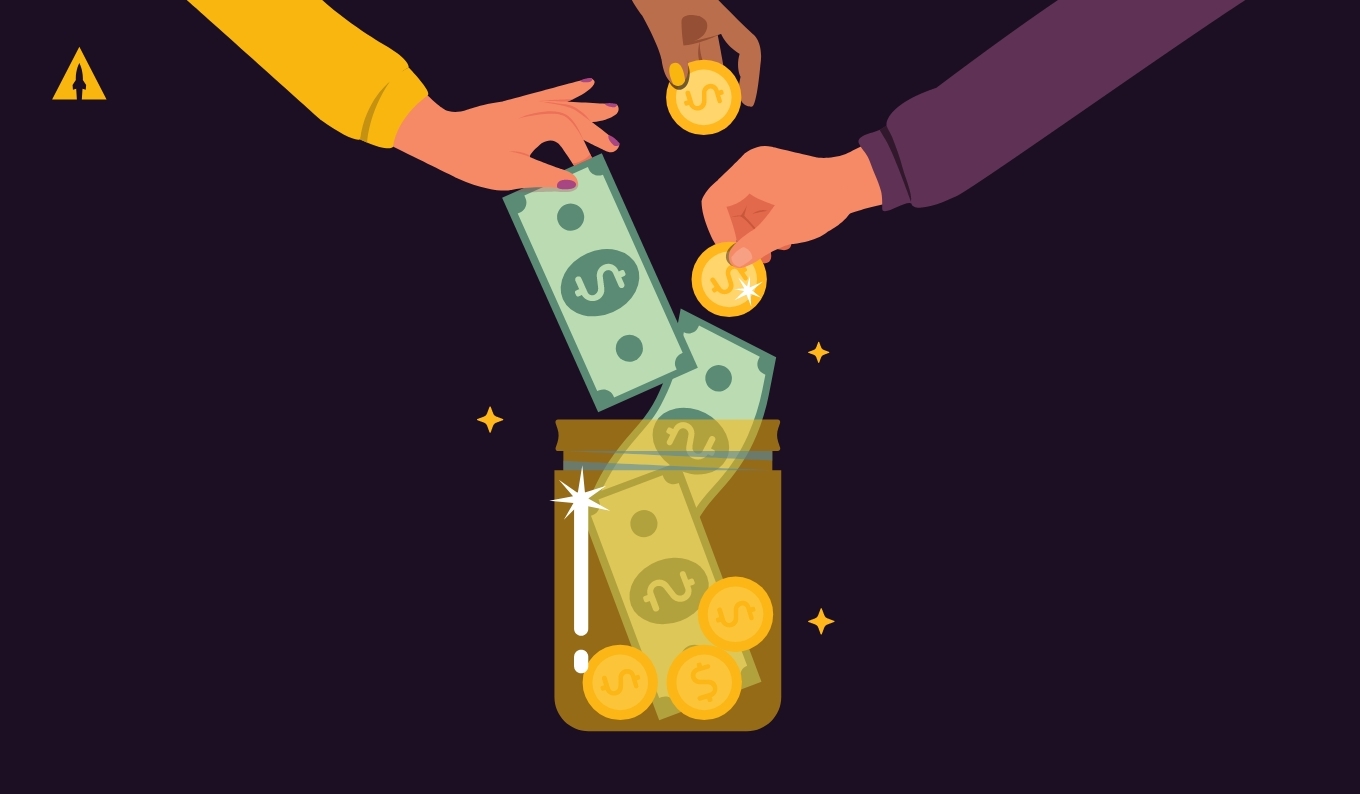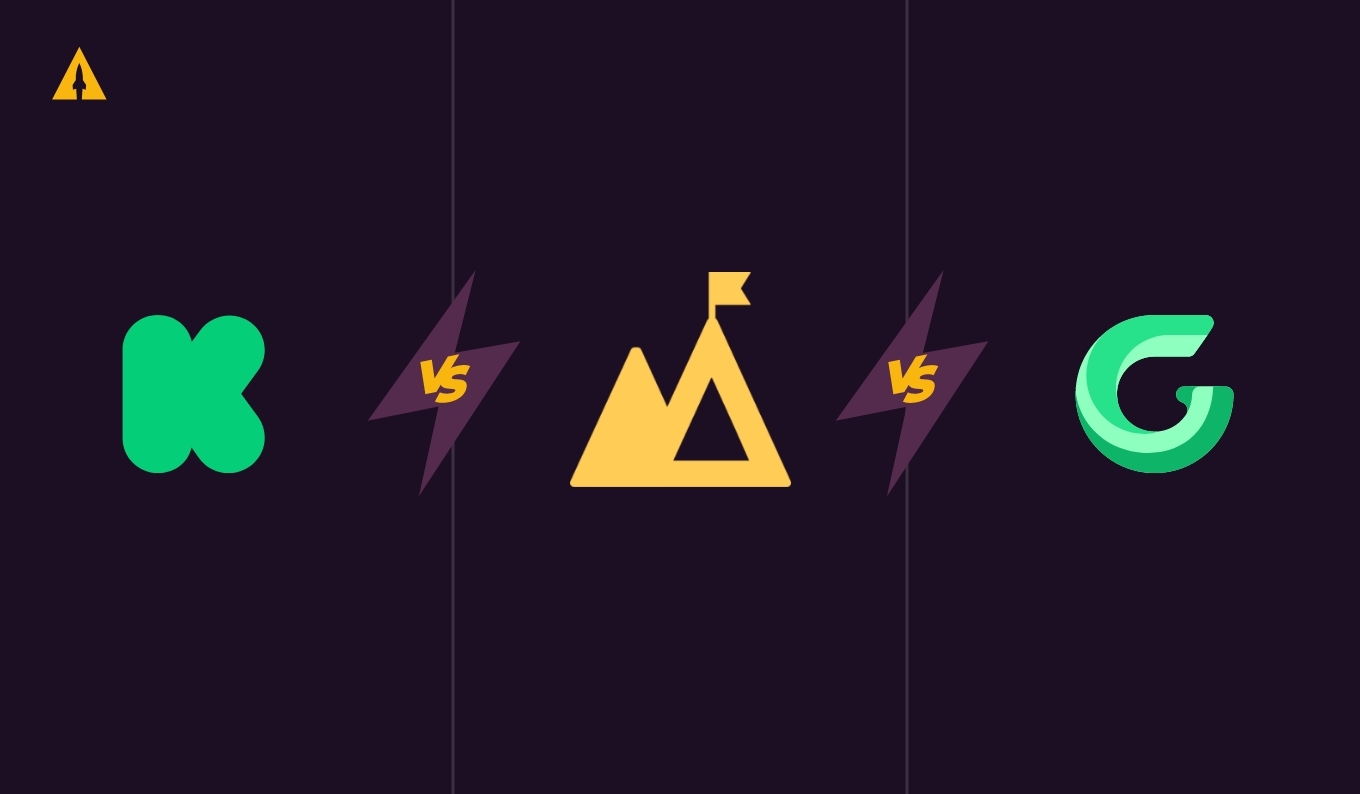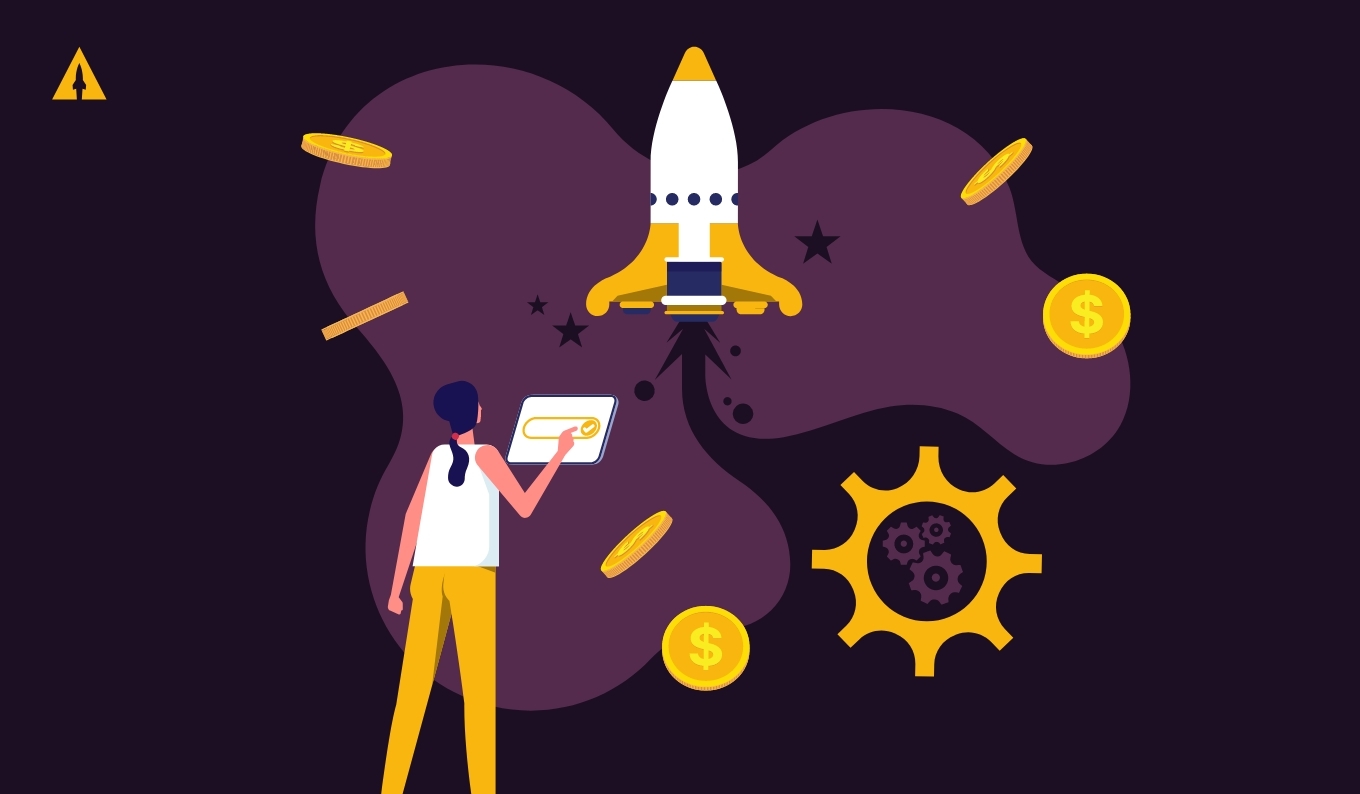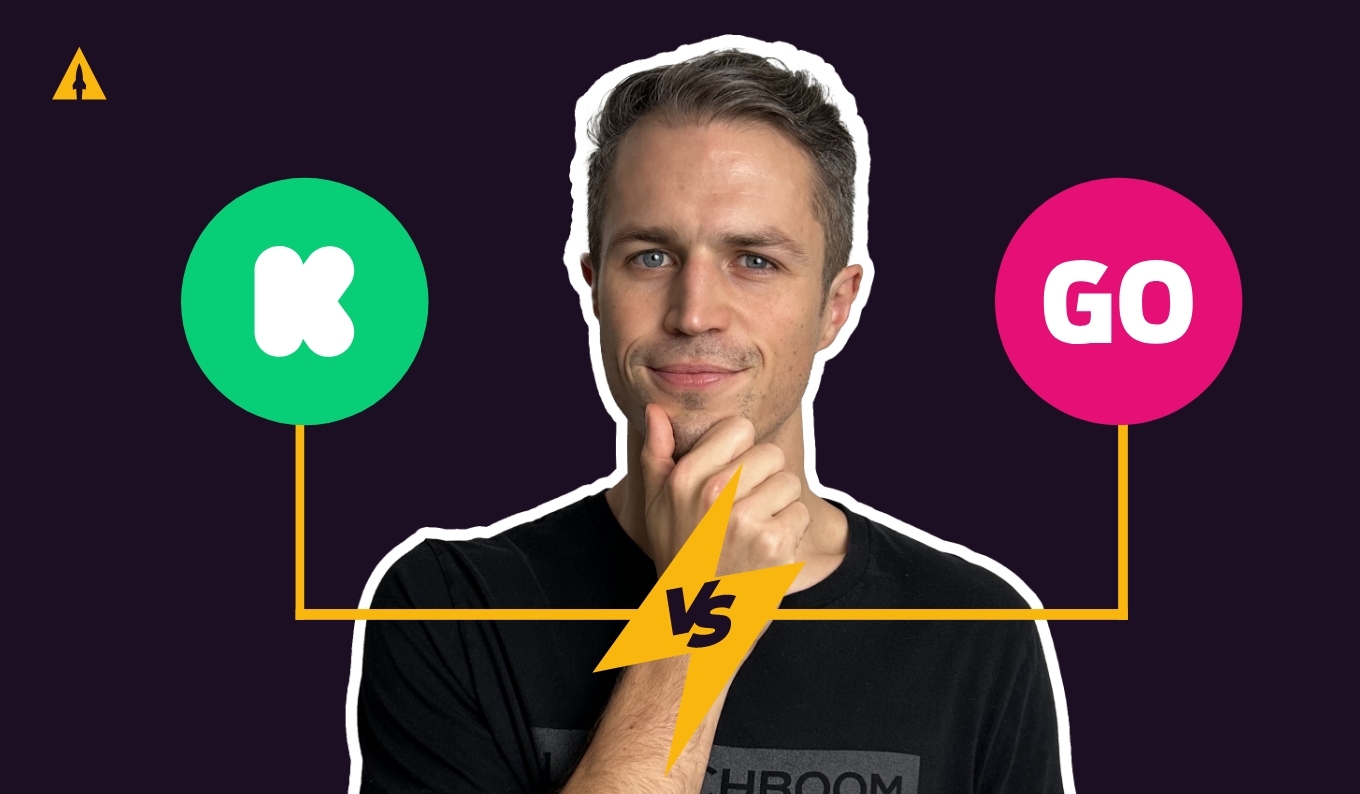
In the quiet moments before Matt Bertulli launched his Lomi campaign, anxiety and excitement battled for dominance. After months of preparation with my team at LaunchBoom, everything was ready, but would the world embrace his innovative composting device? At precisely 9:00 AM, he clicked “launch” and waited. Three minutes later, he stared in disbelief at his screen: fully funded. Within just 10 hours, Lomi had raised over $2 million.
Dusty Droz faced a similar moment of truth with his board game Botany. A tabletop enthusiast with big dreams but no marketing experience, he had followed LaunchBoom’s pre-launch strategy meticulously, building a list of superfans. The result? Funded in just 16 minutes, eventually becoming one of the most successful board game campaigns of the year, raising over $1M.
Tyler Bushnell had a difficult decision to make for his Polycade Sente gaming system. Kickstarter or Indiegogo? Each platform offered distinct advantages. After consulting with LaunchBoom’s crowdfunding experts, he chose his platform and implemented their system. The campaign raised $1 million on the first day without spending a dollar on marketing outside LaunchBoom’s pre-launch strategy.
These creators faced the same pivotal decision that you’re contemplating right now: Kickstarter or Indiegogo? It’s a choice that can dramatically impact your funding success, backer demographics, and post-campaign options.
The biggest reward crowdfunding platforms in the world are Kickstarter and Indiegogo. For creators looking to launch a new product, choosing between these platforms represents one of the most consequential decisions in the crowdfunding journey. But which one is better?
The answer is everyone’s least favorite: it depends. In this case, your product category, project stage, and marketing strategy will influence the answer.
In this guide, I’ll not only put the microscope over how the platforms differ, but give you a clear framework for making the right decision about where to launch. So by the end of this article, you’ll have the knowledge needed to select the right platform for your product launch in 2025.
Contents
- Key Takeaways
- What is Indiegogo?
- What is Kickstarter?
- What’s the difference between Indiegogo and Kickstarter?
- 1. Key Platform Differences
- 2. Marketing & Promotion
- 3. Payment Processing & Fees
- 4. Pre-Launch Features
- 5. Live Campaign Features
- 6. Post-Campaign Features
- Pros and Cons of Indiegogo and Kickstarter
- Kickstarter vs Indiegogo – Which Should You Choose?
- Indiegogo vs Kickstarter: Frequently Asked Questions
Key Takeaways
Kickstarter and Indiegogo differ in several critical ways that impact campaign success:
- Kickstarter has a larger backer community: Kickstarter has developed a larger, more engaged community with higher success rates (42% overall vs. approximately 18-30% for Indiegogo)
- Indiegogo offers more flexibility: Indiegogo offers more flexibility with funding options and fewer restrictions on campaign types, making it suitable for early-stage concepts
- Certain product categories perform better on each platform: Kickstarter demonstrates particular strength in creative projects, games, and design, while Indiegogo performs better in glamping projects and certain hardware categories
- Both platforms have upgraded features for 2025: Kickstarter is introducing integrated pledge management tools, representing a significant platform evolution, while Indiegogo continues enhancing its Drops feature for post-campaign sales
- LaunchBoom has a 97.83% success rate for Kickstarter & Indiegogo launches: in 2024, we had a nearly 98% success rate across both the platforms
What is Indiegogo?
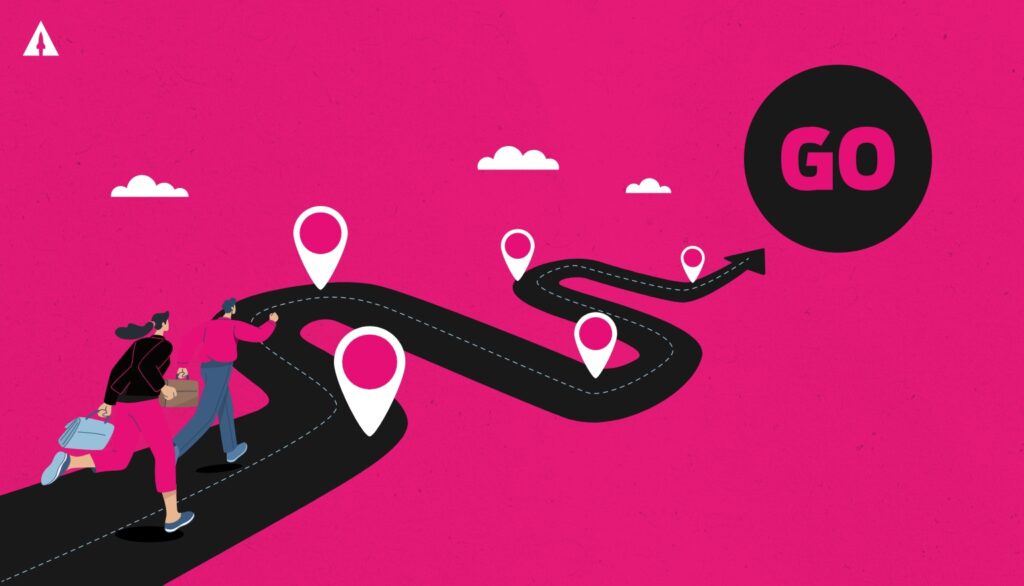
Let’s start with a brief history lesson.
Indiegogo launched in 2008 at the Sundance Film Festival, predating Kickstarter by a year and establishing itself as one of the first dedicated crowdfunding platforms. While it initially focused on independent film projects (hence the “indie” in the name), the platform has evolved significantly over the years to support a diverse range of campaign categories.
Since the beginning, Indiegogo has been more willing to innovate and try new stuff on the platform, often implementing changes and introducing new capabilities ahead of Kickstarter. Not every feature stuck, but many did and became standards in the crowdfunding industry.
In October 2024, Julie dePontbriand became CEO of Indiegogo after previously serving as the company’s Chief Revenue Officer. With a strong background in startups and venture capital, including roles as Cofounder and CEO of Shopventure and Vice President at WeWork, dePontbriand brought valuable entrepreneurial perspective to the platform. Under her leadership, Indiegogo has emphasized personalized creator support and community development. As she explained to Funding Insider at CES 2025, “At Indiegogo we really care about the community… We have a campaign strategy team and they’re real people! They will respond to questions, they will give feedback, and they will provide a level of support.” This focus on guided assistance represents a cornerstone of her vision for the platform.
As of 2025, creators have raised well over $2 billion across more than 800,000 Indiegogo campaigns. The platform claims around 10 million monthly visitors, though Similarweb’s data shows closer to 2.6 million active monthly visits. It’s probably safe to say it’s somewhere in between those two numbers.
What is Kickstarter?
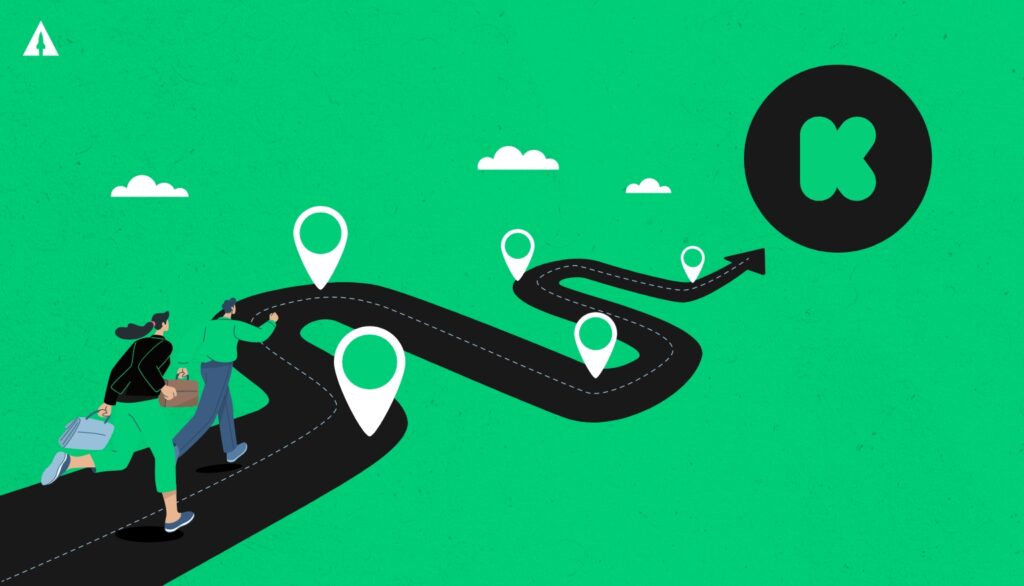
Kickstarter launched in 2009, a year after Indiegogo. They started with creative projects and art, but those categories have gotten smaller as games, technology, and design campaigns took off in both numbers and total funding.
The platform’s origin story begins with founder Perry Chen, who couldn’t get funding for a concert he wanted to put on in New Orleans. In true “the obstacle is the way” fashion, this frustration gave him an idea: build a platform where people could fund creative projects. Chen teamed up with Yancey Strickler and Charles Adler to kickstart Kickstarter.
Fun fact: they used to be called Kickstartr without the “e.” I’m glad they let the “e” join the party.
Just like Indiegogo, Kickstarter has gone through several leadership changes. The biggest one came in September 2022 when they brought in Everette Taylor as CEO. The difference has been night and day. Under Taylor, Kickstarter has found new energy and sped up innovation, making real improvements to the platform after years of not much happening.
You can see this renewed energy in their 2025 product roadmap, which Taylor described as reflecting “our evolution into the all-in-one crowdfunding platform creators have been waiting for.” This is a major shift in strategy for them – and honestly, a smart move.
The numbers speak for themselves. Kickstarter leads the crowdfunding space with more than 651,000 projects launched and over $8.5 billion in pledges. When looking at funding volume, they’re clearly the leader.
What’s the difference between Indiegogo and Kickstarter?
Choosing between Kickstarter and Indiegogo isn’t just about which site looks prettier or which name you like better. It’s about understanding the real differences that can make or break your campaign’s performance, reach, and success.
I’m going to break down these platforms across six key areas:
- Key Platform Differences: How categories perform, success rates, community size, and platform rules
- Marketing & Promotion: Ad programs, newsletter features, and how they help you get the word out
- Payment Processing & Fees: What you’ll pay, funding models, when you get your money, and checkout experience
- Pre-Launch Features: Pre-launch pages and email marketing tools
- Live Campaign Features: Page builders, reward systems, updates, and analytics
- Post-Campaign Features: Late pledge options and fulfillment systems
If you’d rather watch than read, we’ve put together a detailed video on our YouTube channel:
Let’s dive into what really sets these crowdfunding giants apart.
1. Key Platform Differences

Kickstarter and Indiegogo aren’t just different websites – they’ve built completely different worlds that attract different types of projects and backers. You need to understand these key differences to figure out which one will work better for your campaign.
Which Categories Do Well on Kickstarter and Indiegogo?
Both platforms can handle pretty much any category, but certain products just do better on one versus the other. It happens naturally – when a category does well on a platform, similar projects follow, which brings in more backers who like those products.
This creates a snowball effect that smart creators can use to their advantage. So first, I want to point out the categories that tend to do better on each platform.
| Category | Kickstarter Performance | Indiegogo Performance |
| Games | Strong | Poor |
| Technology | Strong | Strong |
| Product Design | Strong | Moderate |
| Creative (film, music, art) | Strong | Poor |
| Hotel & Glamping | Poor | Strong |
Best Categories for Kickstarter
There are three categories that tend to perform better on Kickstarter.
#1: Games
With $2.63 billion in lifetime pledges, games – especially tabletop games – are Kickstarter’s bread and butter (and its biggest category). They’ve built a community of game lovers who actively hunt for new projects.
That means, if you have a game, there’s no need to read the rest of this article, just launch on Kickstarter like our client Aaron from Littlest Lantern.
He launched his game Sea Beasts on Kickstarter and raised $672,720 against a tiny $15,000 goal—hitting 4,485% of its target with 5,414 backers. That’s the power of Kickstarter’s gaming community.
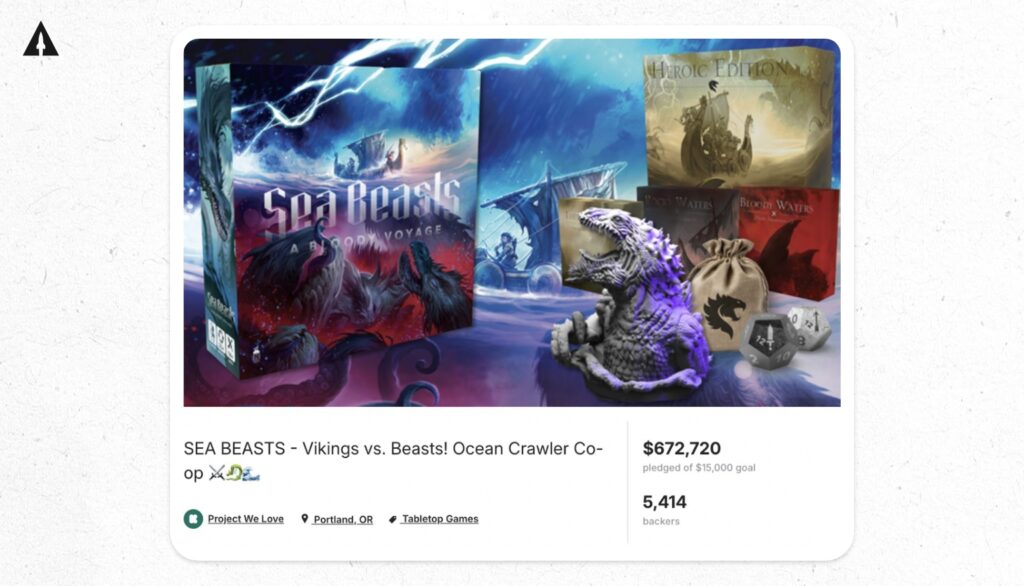
#2: Design-Forward Consumer Products
Products that lean heavily on design aesthetics as a core feature of the product tend to do better on Kickstarter. Reading that last sentence back is a little confusing, so let’s look at an example.
Our client Joseph launched the Fuse Audio GLD on Kickstarter which is a vertical record player. A record player isn’t innovative, but a vertical one that looks like a piece of art is. This campaign went on to raise $631,249.
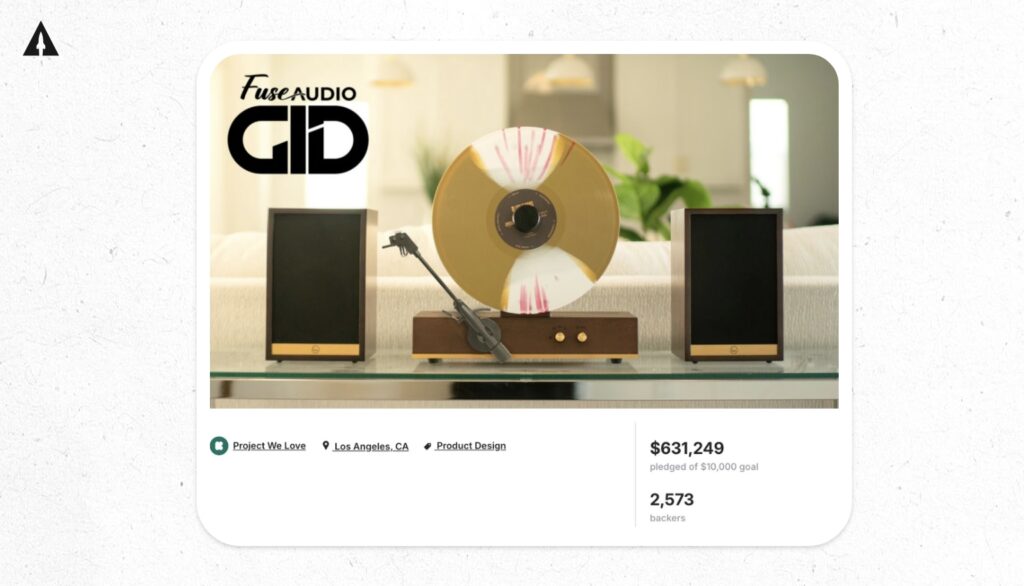
#3: Creative & art
Even though Indiegogo started as a platform for films, it’s more known for non-creative categories which I’ll get to in a second. So if you have a creative project in film, art, music, etc. you’ll want to go on Kickstarter. Even though these categories aren’t that big in comparison to other categories on Kickstarter, they are still much bigger than on Indiegogo.
Plus, Kickstarter has invested a lot in supporting artists – acquiring The Creative Independent and offering Forward Funds where they’ve partnered with organizations that provide funding for creative projects.
Best Categories for Indiegogo
There are two categories that tend to perform better on Indiegogo.
#1: Hotels & Glamping
Sounds random, but hotels & glamping projects do really well on Indiegogo. One main reason is because photorealistic renderings aren’t allowed on Kickstarter and all the glamping projects use them. So for now, this is one of those categories where if your project is in it, you know which category to go with: Indiegogo.
We helped launch the biggest glamping project ever called Kosmos in 2024, raising $1,916,235.
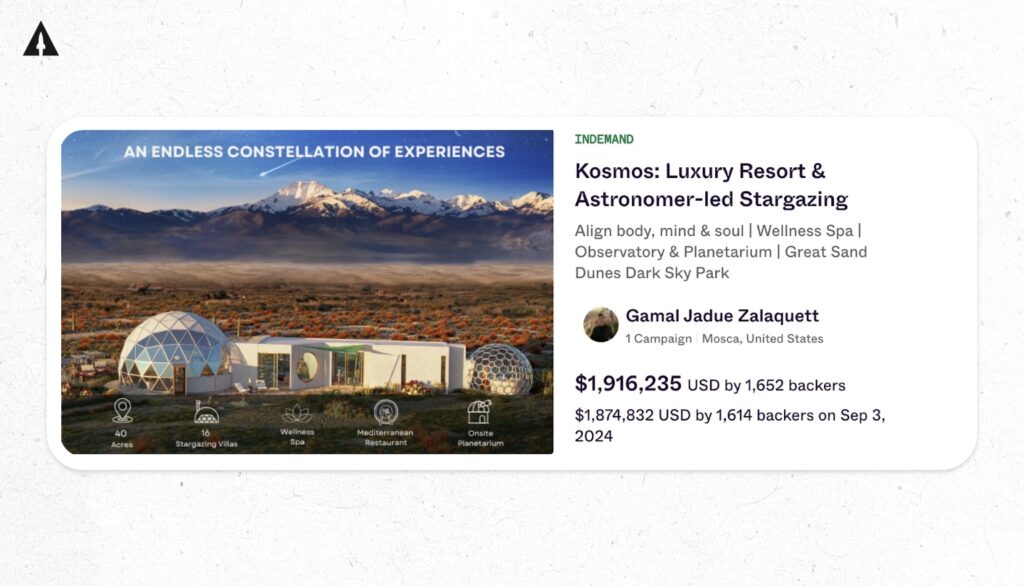
#2: E-bikes & e-mobility
The whole e-bike & e-mobility space has been more popular on Indiegogo. In my experience, we’ve seen e-bikes in particular do really well. For example, check out this campaign called Bonc Bike we helped launch that raised $859,422.
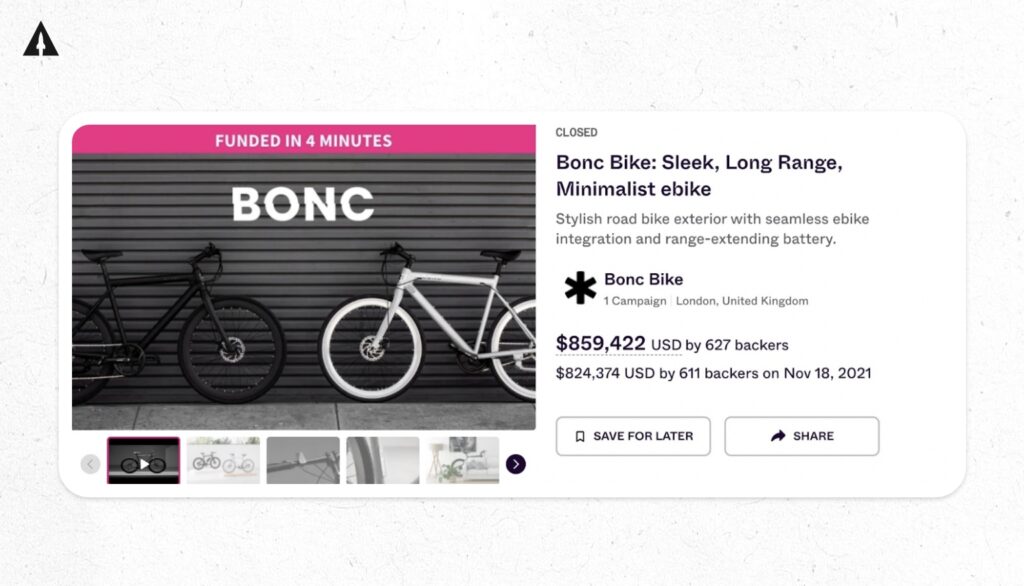
What Won’t Work on Kickstarter and Indiegogo?
While both platforms encourage creative freedom, not everything works well on crowdfunding sites.
Software and apps almost always bomb on these platforms. Here’s why: even though they cost a fortune to develop, most apps are either free or cost just a few bucks to download. There’s just no good reason for backers to “pre-order” something they expect to be cheap or free anyway. The math simply doesn’t add up.
B2B products don’t do well either. The people scrolling through Kickstarter and Indiegogo are looking for cool stuff for themselves or gifts for friends – not solutions for their company’s supply chain problems. The audience just isn’t there.
Get-rich-quick schemes are flat-out banned on both platforms. This isn’t surprising – crowdfunding is built on the idea that creators and backers both win. Both Kickstarter and Indiegogo take their anti-scam policies seriously to protect their communities.
There are other no-go areas too: alcohol, drugs, drug paraphernalia, and weapons aren’t allowed on either platform.
One key difference: Kickstarter doesn’t allow charity campaigns while Indiegogo does. Kickstarter even restricts creators from giving a portion of funds to charity, though you can still do buy-one-give-one models if that’s part of your mission.
Success Rate
Alright, now let’s talk success rates – they can tell you a lot about which platform might work better for your campaign.
| Platform | Overall Success Rate | Top Category Success Rate |
| Kickstarter | ~42% | Games (Tabletop): 80% |
| Indiegogo | ~18-30% (estimated) | Technology: ~35-40% (estimated) |
Kickstarter Success Rates
Kickstarter’s overall success rate sits at 41.98% as of January 2025, across more than 651,000 launched projects. That’s pretty impressive when you consider their all-or-nothing model – you either hit your goal or get zero dollars. No middle ground.
The success rates jump around depending on what you’re launching:
- Tabletop games: 80% (as of 2024, the highest it’s ever been)
- Comics: 67.64%
- Dance: 61.11%
- Theater: 59.73%
Indiegogo Success Rates
Indiegogo plays things close to the vest – they don’t publish their success rates. But the best estimates we have put them somewhere between 18-30%. Why the big difference from Kickstarter? Two main reasons:
- Indiegogo approves a lot more types of projects, including concept-stage and riskier projects that might not make it
- They offer flexible funding, where campaigns keep whatever they raise even if they don’t hit their goal, which might make some creators less motivated to push for full funding
We don’t see that big of a difference between the success rate of our Kickstarter and Indiegogo campaigns. In fact, our success rate across both platforms was 97.83% in 2024. We were able to have such a high success rate because we helped our clients choose the right platform for their product and had them follow our marketing system.
If you want to see what that is, watch this video from our YouTube channel:
Community and Platform Size
The community on each platform matters – a lot. Because by launching on Kickstarter or Indiegogo, you can tap into their backer communities and get free traffic (and funding) if you know what you are doing. Platform discoverability is one of the main reasons why I recommend crowdfunding for a product launch vs. launching on your own website.
| Platform | Total Community Size | Monthly Visits | Repeat Backer Percentage |
| Kickstarter | ~23.87 million backers | ~27.3 million | ~34.7% |
| Indiegogo | ~9 million backers | ~2.6 million | Limited data available |
Kickstarter’s Community
Kickstarter has built an impressive backer community:
- 23.87 million total backers
- 8.29 million repeat backers as of January 2025 (about 34.7% of all backers keep coming back)
- According to SimilarWeb, they have 27.3 million monthly visits with people spending nearly 7 minutes per session
- Strong presence across multiple countries with the US leading at 47.3%, followed by the UK, France, Canada, and Germany
Here’s something really valuable about Kickstarter’s community – they jump around between categories. Data from 2024 shows that 70% of Games category backings came from people who also backed projects in Design, Technology, Comics, and Publishing. This creates a discovery network that helps creators in all categories by expanding their potential audience beyond their main category.
Indiegogo’s Community
Indiegogo’s community is smaller, with about 9 million total backers, and they’re less transparent with their data:
- According to SimilarWeb, the platform gets around 2.6 million monthly visits with shorter sessions of just 2 minutes
- Similar geographic spread to Kickstarter, with the US, UK, Canada, and European markets leading
- The limited data we have suggested fewer repeat backers and less category-hopping than on Kickstarter
When we look at how backers behave across both platforms, we see clear differences. Kickstarter consistently shows stronger repeat backer numbers and higher average projects backed per user. Plus, in general, Kickstarter projects tend to have better organic discoverability vs. Indiegogo.
Platform Rules – what won’t work on Kickstarter & Indiegogo?
The two platforms play by very different rules when it comes to what projects they’ll accept. This matters a lot depending on where you are in your product journey.
Kickstarter’s Rules
Kickstarter runs a tight ship with some strict guidelines:
- Prototype Requirement: You absolutely must have a working prototype before launch. No exceptions. This ensures you’re beyond just the “idea” phase and increases the chances you’ll actually deliver.
- Campaign Review: They check every campaign before letting it go live. Think of it as quality control that helps keep backers confident.
- No Reselling: You can’t just rebrand something that already exists. You need to create something new.
- No Charity: Want to raise money for a good cause? Look elsewhere. Kickstarter requires you to make something to share with your backers.
- No Equity Offerings: You can’t offer shares in your company or revenue sharing. It’s all about the rewards.
These stricter rules make it harder to get in the door but create more trust in the Kickstarter ecosystem. This probably contributes to their higher success rates.
Indiegogo’s Rules
Indiegogo takes a more “come as you are” approach:
- Product Stages: They use a transparency system that lets campaigns launch at different development stages:
- Concept: You’ve got detailed renderings but no physical prototype yet
- Prototype: You have working prototypes but haven’t started production
- Production: You’ve begun manufacturing
- Shipping: You’re actively fulfilling orders
- Post-Launch Review: They might review your campaign after it’s already live rather than making you wait for pre-approval.
- Broader Acceptance: They welcome a wider range of projects, including causes and charity campaigns that Kickstarter would reject.
- Similar Prohibitions: They’re still strict about some things, like equity offerings and weapons.
Here’s a real example of why this matters: Our client Kosmos launched successfully on Indiegogo with just architectural renderings and detailed plans – no physical structure yet. Kickstarter would have shown them the door because of their prototype requirement. This shows how Indiegogo’s flexibility can open doors for innovative projects that don’t fit the traditional crowdfunding mold.
| Aspect | Kickstarter | Indiegogo |
| Prototype Requirement | Functional prototype required | Concept-stage projects accepted |
| Approval Process | Pre-launch review required | May review after launch |
| Project Types | Creative projects, products | Broader range, including causes |
| Prohibited Items | Energy drinks, political campaigns, weapons | Fewer restrictions, similar prohibited items |
Customer Support
If this is your first time crowdfunding, you’re probably very curious about the customer support each platform offers.
Well, both platforms have built pretty good help centers with tons of documentation on how to use their features, best practices, and solutions to common problems. Here is Kickstarter’s support and here’s Indiegogo’s support. For many creators, these DIY resources won’t be enough.
If you’re looking to talk to a human, both platforms offer email support, but don’t expect lightning-fast responses. You’re typically looking at 24-48 hours before hearing back. And honestly, the quality of help varies depending on how complicated your question is and how busy their support team happens to be.
Here’s something you should know upfront: it’s pretty unlikely that either platform will give you a dedicated account manager unless you’re bringing some serious marketing dollars to the table. While they do have creator outreach teams, their main focus is on building scalable platforms, not holding your hand through the process.
To fill this support gap, both Kickstarter and Indiegogo have created Expert Directories where they connect creators with professionals who specialize in crowdfunding campaigns. LaunchBoom is both a Kickstarter Certified Expert and an Indiegogo Certified Expert, so we provide the specialized support that the platforms themselves don’t offer.
Creator Education
Both platforms know that educated creators run better campaigns, so they’ve each invested in creator education to help you learn the ropes.
Kickstarter has put together a more comprehensive Creator Resources section with guides, case studies, and webinars that cover everything from how to build your page to fulfilling orders. The big news here is that Kickstarter recently partnered with us at LaunchBoom to create Learning Lab – a comprehensive and free course that helps creators master Kickstarter fundamentals through structured learning paths and expert insights.
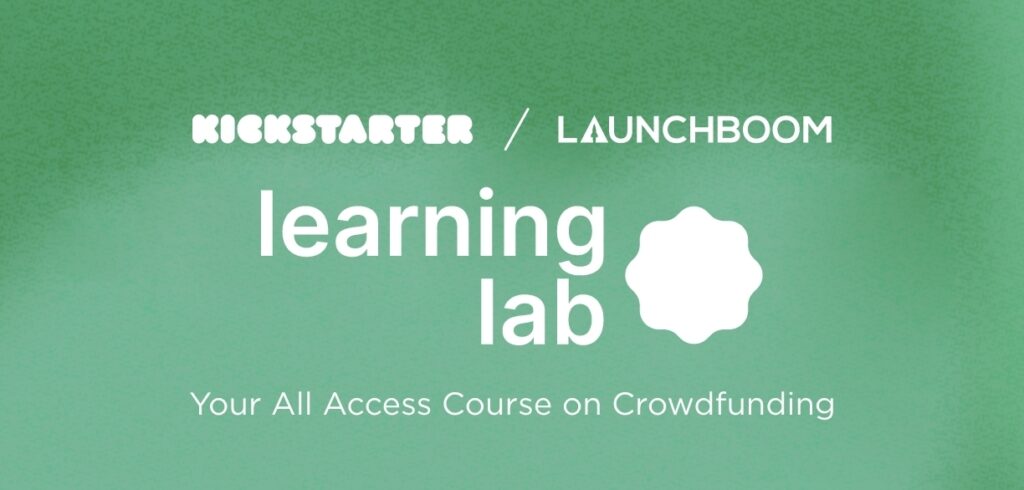
Indiegogo hasn’t been sleeping on creator education either. Their Education Center includes articles, templates, and best practices to help you build a strong campaign.
These educational resources go way beyond the basic platform features. They help you develop the skills and knowledge you need to maximize your chances of success. And trust me, in crowdfunding, knowing what you’re doing makes all the difference.
Countries that can launch
Where you live actually matters a lot when choosing between these platforms – some creators simply don’t have both options on the table.
Kickstarter currently supports creators from 25 countries: the United States, United Kingdom, Canada, Australia, New Zealand, the Netherlands, Denmark, Ireland, Norway, Sweden, Germany, France, Spain, Italy, Austria, Belgium, Switzerland, Luxembourg, Hong Kong, Singapore, Mexico, Japan, Poland, Greece, and Slovenia.
Indiegogo casts a slightly wider net with 33 countries: Australia, Austria, Belgium, Canada, Cyprus, Denmark, Estonia, Finland, France, Germany, Greece, Hong Kong (China campaigns may be eligible), Republic of Ireland, Italy, Japan, Latvia, Lithuania, Luxembourg, Malta, Mexico, Netherlands, New Zealand, Norway, Poland, Portugal, Singapore, Slovakia, Slovenia, Spain, Sweden, Switzerland, the UK and US.
Why the limitations? It all comes down to their payment processor, Stripe. Both platforms can only operate in countries where Stripe does business.
If you’re not in one of these countries, don’t give up just yet. Stripe Atlas offers a potential workaround. This service helps entrepreneurs set up a US-based business entity and bank account that you can use to launch crowdfunding campaigns on either platform. It’s not the easiest path, but it opens doors for international creators who’d otherwise be left out.
2. Marketing & Promotion
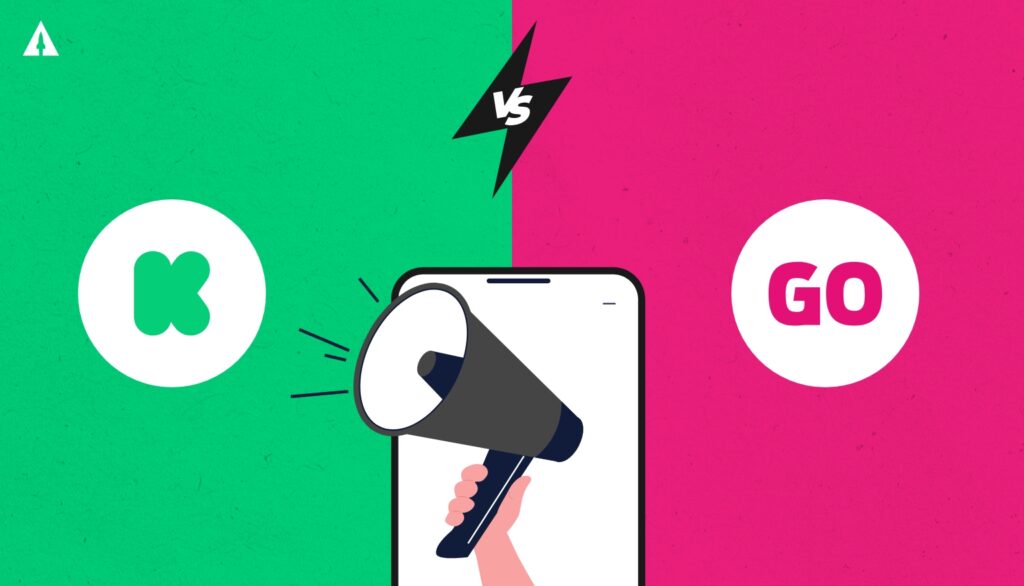
The marketing and promotion tools each platform offers can make a huge difference in how many people see your campaign, how many convert to backers, and ultimately how much funding you raise. Let’s break down the differences so you can build the right strategy for each platform.
Performance Marketing
Both platforms have built their own in-house performance marketing teams to help creators amplify their campaigns through ads. This is great news if you’re not a marketing expert but still want to benefit from paid advertising. As the name suggests, “performance” marketing differs from other forms of advertising services because you only pay when they perform – in the case of crowdfunding, that typically is when they get a sale for your campaign.
Kickstarter Performance Marketing
Starting in 2024, Kickstarter’s performance marketing team is relatively new. They still technically are in beta, meaning the amount of creators that are accepted to work with them is still pretty low. Here’s how it works now:
- They can run ads during the pre-launch and live campaign
- If they run ads during the pre-launch, they will charge a percentage of the ad spend
- If they run ads during the live campaign, they will charge a percentage of the revenue they bring to the campaign
- They provide all the creative needed for the ads
- They place ads mainly across Facebook and Instagram
- They tap into their backer audiences for targeting purposes
- You have limited control over campaign optimization decisions
If you want to sign up for the beta, you can use this form.
Indiegogo Performance Marketing
Indiegogo’s performance marketing team has been around for longer and operates essentially the same as Kickstarter’s. If you want to learn more about what they call their Digital Services team, you can go here.
At the end of the day, if you’re already an advertising pro, these platform-managed options might not add much value compared to running campaigns yourself. But if you don’t have digital marketing experience or want to supplement your own efforts, these programs can give you valuable extra exposure from teams who really understand crowdfunding marketing.
| Feature | Kickstarter | Indiegogo |
| Ad Management | Platform handles | Platform handles |
| Payment Model | Revenue share & percentage of ad spend | Revenue share & percentage of ad spend |
| Stages | Pre-launch & live campaign | Pre-launch & live campaign |
| Campaign Control | Limited | Limited |
| Minimum Budget | Required | Required |
Newsletters
Getting featured in platform newsletters can be a game-changer for your campaign. These emails go out to thousands of active backers and can drive serious pledges from people who already trust the platform.
Each platform handles their newsletters differently, and understanding these differences helps you maximize your chances of getting featured.
Kickstarter’s Newsletter
Kickstarter sends out several types of newsletters:
- Category-specific newsletters that highlight selected projects
- Projects We Love features that showcase campaigns their team has personally chosen
- Personalized recommendations based on what backers have supported before
These newsletters can drive major traffic and pledges to your campaign, but Kickstarter keeps tight control over what gets featured. They’re generally not open to negotiating guaranteed placements – it’s mostly merit-based and decided by their editorial team.
Here’s an example of what one of Kickstarter’s newsletters look like:
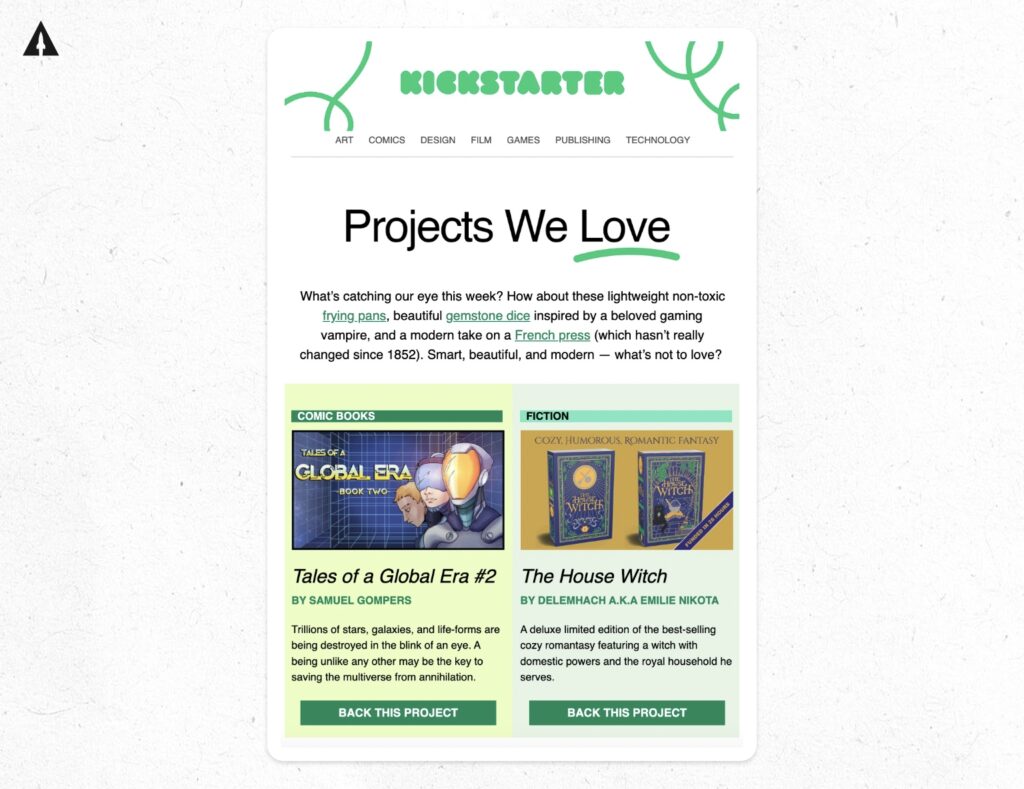
Indiegogo’s Newsletter
Indiegogo takes a slightly different approach with their newsletter program:
- Like Kickstarter, they have category newsletters and staff picks
- Unlike Kickstarter, they’re typically more willing to discuss newsletter placements if your campaign shows strong early performance
- They’re more flexible about customizing promotional spots for campaigns working with their marketing programs
We’ve seen that getting featured in Indiegogo’s newsletter typically leads to better results for creators. For example, we helped launch iXi on Indiegogo in February of 2025 and it raised $77,434 directly from their newsletter. With $818,311 in total funds raised, Indiegogo’s newsletter made up nearly 10% of all the funding.
Platform Promotions
Beyond newsletters, both platforms offer various promotional spots across their websites that can dramatically boost your campaign’s visibility to potential backers.
Kickstarter Promotions
Kickstarter’s promotional system is all about editorial selection rather than paid placements:
- Project We Love Badge: This is the golden ticket on Kickstarter. Getting this badge significantly increases your visibility and credibility. It appears right on your campaign page and signals quality to potential backers. Projects with this badge also get first dibs on other promotional opportunities across the platform. Here’s an example of our client Jiffy’s who got the Project We Love badge:
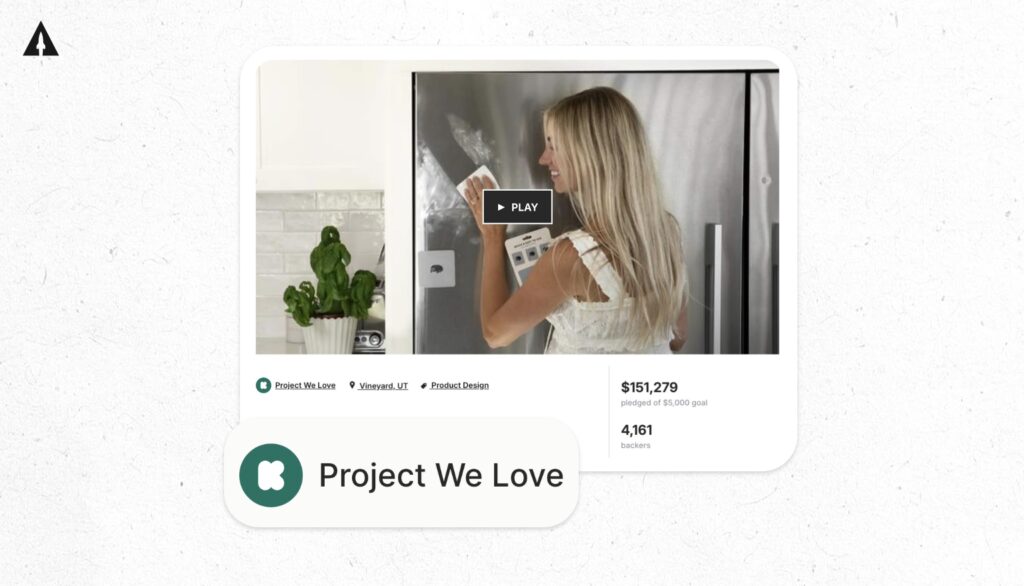
- Homepage Placement: Getting featured on Kickstarter’s homepage means massive exposure to casual browsers and returning visitors. Unlike some platforms, these spots are determined by their editorial team, not by who’s willing to pay the most.
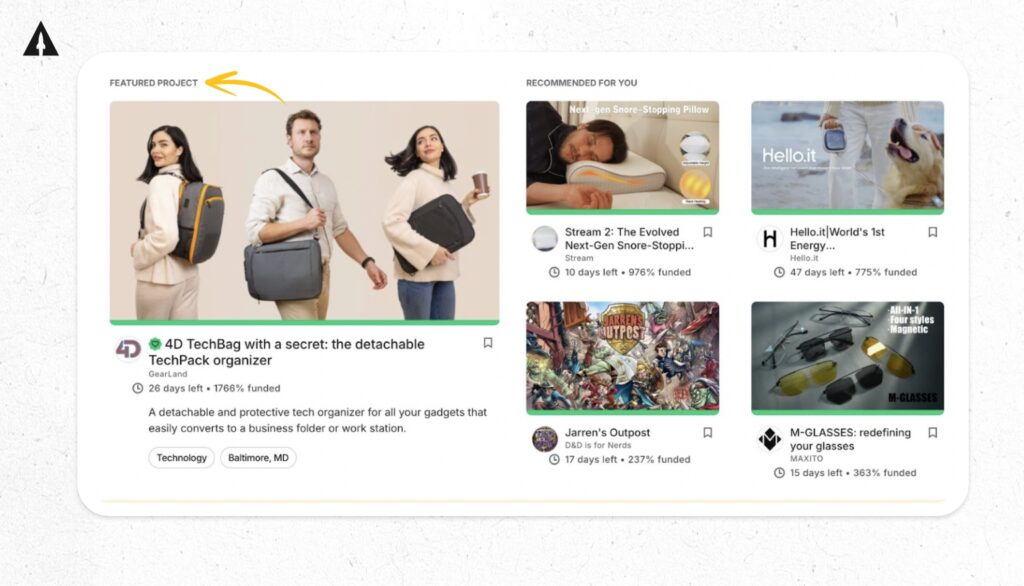
- Category Features: Your project might get prominent placement within its specific category pages, putting you front and center for backers looking for your type of product. Here’s an example of our client, ChillShark, being featured:
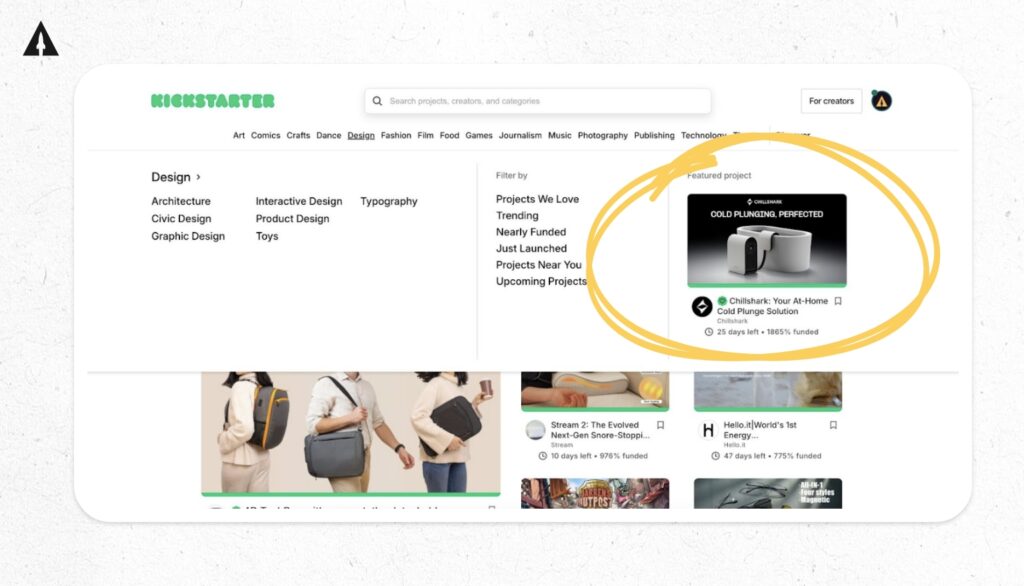
The big thing to understand about Kickstarter is they don’t sell promotional placements on their homepage or category pages. All these features are chosen through editorial processes based on project quality, innovation, and alignment with their values.
To improve your chances of earning these valuable promotional spots, focus on:
- Creating compelling visuals and clear campaign messaging
- Showing what makes your product unique and innovative
- Building momentum early through pre-launch audience development
- Maintaining high quality throughout all your campaign materials
Indiegogo Promotions
Indiegogo takes a mixed approach, combining editorial selections with paid opportunities:
- GOGOPicks: Similar to Kickstarter’s Projects We Love, these selected campaigns get a badge and increased visibility. This is where Indiegogo differs – it’s not free. But the additional investment may be worth it if you have a marketing budget and want a more predictable path to increased exposure. Here’s an example of our client, The Shoe Steamer, who got the GOGOPick badge:
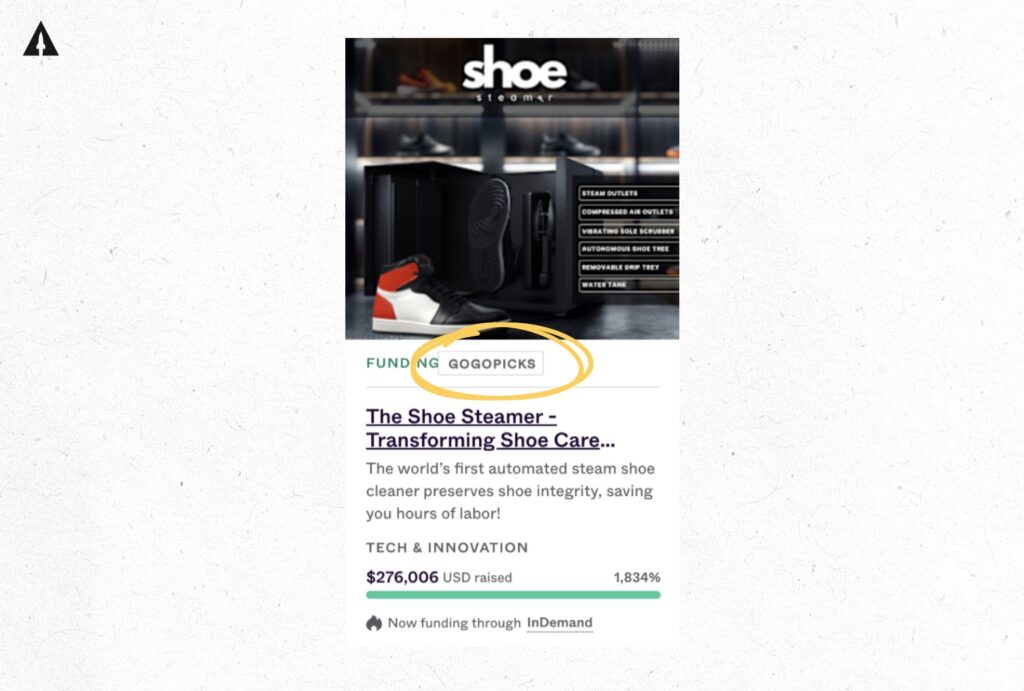
- Collections: This is Indiegogo’s editor team in action. Here, they group projects into themed collections that receive dedicated promotion. Some collections are purely editorial picks, while others allow paid inclusion. Here’s an example of two of our clients, Base Case & Brighter in the top 10 list of their most popular collection:

- Trust Proven: This is where Indiegogo will give campaigns a special Trust Proven badge if they meet a certain criteria. Essentially, it’s a way to add credibility and instill trust in potential backers that the campaign they are considering is trustworthy and will likely ship the product. If you want to learn more about the program, you can read their help article here.
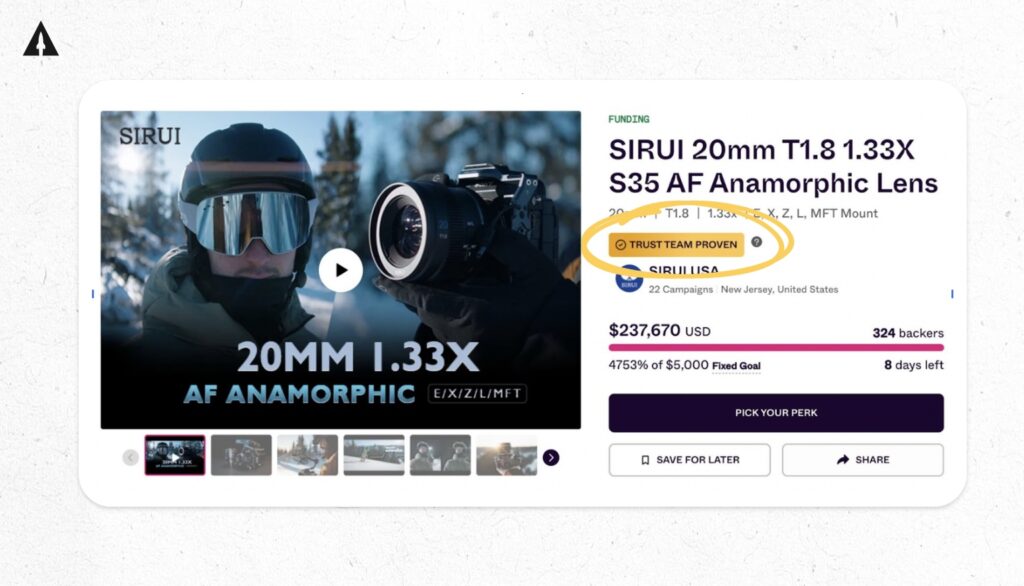
The availability of paid promotional spots on Indiegogo is a major difference between the platforms. It allows creators with marketing budgets to secure visibility that would otherwise depend on being selected by the editorial team. This creates more predictable promotional paths but also changes the competition dynamics compared to Kickstarter’s merit-based approach.
| Feature | Kickstarter | Indiegogo |
| Editorial Features | Project We Love badge | Collections |
| Paid Placements | Not available | Yes, with GOGOPicks |
| Homepage Access | Editorial selection only | Can be purchased |
| Negotiation | Limited | More flexible |
3. Payment Processing & Fees
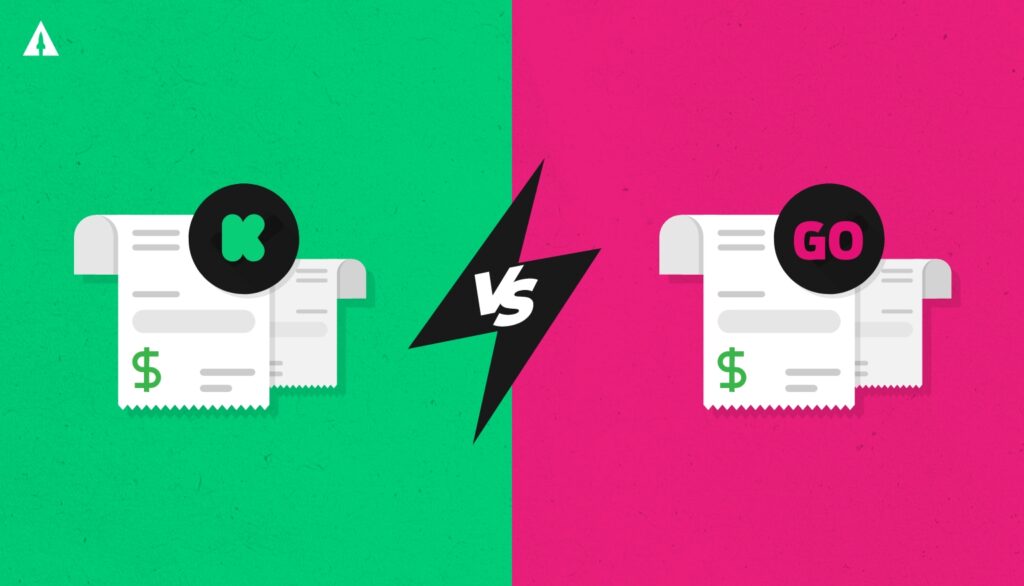
“Payment processing & fees! Sounds like a riveting topic, Mark!” I promise you that it’s not only important, but there’s some pretty interesting stuff in here too. How each platform handles payments will directly affect your bottom line, so understanding it is worth it.
Platform Fees
Both Kickstarter and Indiegogo make their money by taking a cut of successfully funded campaigns and there really isn’t that much of a difference between the two.
What are Kickstarter’s Fees?
Kickstarter has a straightforward fee structure:
- Platform Fee: 5% of total funds raised
- Payment Processing: For US campaigns, 3% + $0.30 per pledge
- Micropledge fee: If a backer pays $10 or less then there’s a discounted “micropledge fee” of 5% + $0.08 per pledge
- International Fees: Vary by country, with additional currency conversion fees for non-domestic payments
The big thing to remember with Kickstarter is you only pay these fees if your campaign succeeds. If you don’t hit your funding goal, you don’t pay a dime since no pledges are processed. That’s consistent with their all-or-nothing approach (which I’ll explain in a moment).
What are Indiegogo’s Fees?
Indiegogo’s base fee structure looks similar but has some key differences:
- Platform Fee: 5% of total funds raised
- Payment Processing: For US campaigns, 3% + $0.20 per transaction
- International Fees: Vary by country with specific rates detailed in their fee documentation
Importantly, these fees apply regardless of whether a campaign uses fixed funding (all-or-nothing) or flexible funding models. For detailed fee information specific to your country, refer to Indiegogo’s fee documentation or Kickstarter’s fee page.
| Fee Type | Kickstarter (US) | Indiegogo (US) |
| Platform Fee | 5% | 5% |
| Payment Processing | 3% + $0.30 | 3% + $0.20 |
| Micropledge Fee | 5% + $0.08 | 3% + $0.20 |
| International Variability | Country-specific | Country-specific |
Funding Schemes
The way each platform handles funding is one of the biggest differences between Kickstarter and Indiegogo, and it affects everything from your campaign strategy to how backers think about supporting you.
Kickstarter Funding Model
Kickstarter only does one thing: all-or-nothing funding.
- You only get money if you reach or exceed your funding goal
- If you don’t hit your goal, no backers get charged at all
- This creates natural urgency and gives people reasons to help you reach your target
This approach has some real advantages. By making sure you either get your full funding goal or nothing, it reduces the risk of underfunded projects that can’t deliver what they promised. It also creates powerful momentum as you get close to your goal – existing backers often start sharing like crazy and even increasing their pledges because they want to see you succeed.
Indiegogo Funding Models
Indiegogo gives you two different options:
Fixed Funding (All-or-Nothing):
- Works just like Kickstarter’s model
- You only get funds if you reach or exceed your goal
- Creates the same urgency and momentum
Flexible Funding:
- Lets you keep all funds raised even if you don’t hit your goal
- Reduces the urgency for backers to help you reach your target
- You still have to fulfill rewards regardless of how much you raise
While flexible funding sounds great at first, it can actually hurt your campaign by reducing urgency and backer confidence. When backers know your project will happen no matter what, they’re less motivated to share your campaign or increase their pledges. Some backers are also hesitant to support projects that might be underfunded but still obligated to deliver.
The all-or-nothing model generally creates better alignment between what you need as a creator and what gives backers confidence. This approach is healthier for the whole crowdfunding ecosystem because it reduces the risk of failed fulfillment and builds trust in the platform.
When Do They Pay You?
When you actually get your money differs quite a bit between platforms, and this impacts your cash flow and fulfillment planning.
Kickstarter Payout Timing
Here’s how Kickstarter’s payment process works:
- Backers’ cards are only charged when your campaign successfully ends
- About 2-5% of payments fail during this process due to expired cards, insufficient funds, or fraud alerts
- You’ll typically get your money about 14 days after your campaign ends
- If you’re outside the US, you might wait a bit longer depending on your country’s banking rules
The delayed charging model means that while Kickstarter shows the full pledge amount during your campaign, you should expect to get about 3% less than what’s displayed due to payment failures. Make sure you factor this into your financial planning and manufacturing calculations.
Indiegogo Payout Timing
Indiegogo handles payments completely differently:
- Backers are charged immediately when they pledge, regardless of where your campaign stands
- This eliminates the payment failure issue you’d face on Kickstarter
- Your first payment arrives within 15 business days after your campaign ends
- For campaigns raising more than 1,000 in your currency, Indiegogo holds 5% of your funds in reserve for potential refunds. This is called reserved funds.
- These reserved funds are released about 6 months after your campaign ends
This immediate payment model gives you more certainty about how much money you’ve actually raised, but that 5% reserve hold can impact your cash flow for manufacturing and fulfillment. For big campaigns, this reserved amount can be significant money that you won’t have available during initial production.
| Aspect | Kickstarter | Indiegogo |
| When Backers Are Charged | Campaign end | Immediately upon pledging |
| When Creators Receive Most Funds | ~14 days after campaign end | ~15 business days after campaign end |
| Funds Retention | None | 5% reserved until fulfillment |
| Card Failure Rate | 2-5% | Minimal (charged at pledge time) |
Pay Over Time
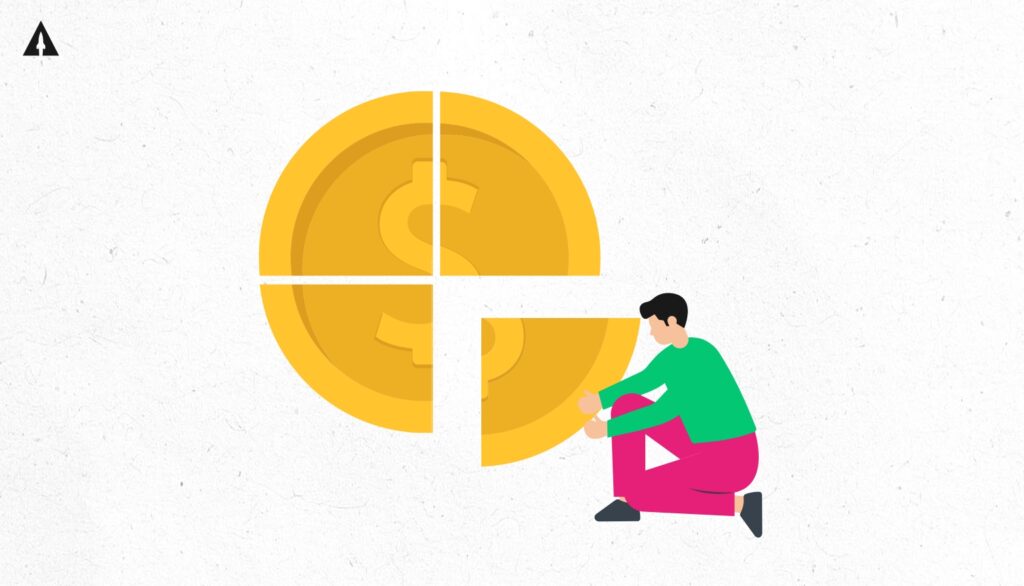
Both platforms have added payment flexibility features that make higher-priced items more accessible to backers and boost conversion rates for premium products. This “Pay Over Time” option is a game-changer in crowdfunding payments. Instead of having to pay everything upfront, backers can split their pledge into multiple payments.
Kickstarter’s version (still in beta) lets eligible backers divide their pledge into 4 payments for pledges over $125.
- Assuming the campaign is successful, the first payment happens when the campaign ends
- The remaining 3 payments are split equally and paid every 2 week automatically
- Backers need to complete all payments before getting their rewards
You can find more details in Kickstarter’s Pledge Over Time documentation if you’re curious.
Indiegogo’s pay over time feature is also in beta and works like this:
- Splits the payment into 4 equal monthly payments
- Available for pledges from $400 to $20,000
- First payment processed right away
- Future payments automatically charged monthly
Check out Indiegogo’s Pay Over Time documentation for the complete details.
These payment options have made a real difference in conversion rates for higher-priced items by lowering the initial payment hurdle. They effectively tackle that “sticker shock” for premium rewards, making them more accessible to backers who might otherwise back away from higher prices.
Checkout
The checkout experience is another area where the platforms are quite different, affecting how backers select and buy rewards.
Indiegogo Checkout
Indiegogo’s checkout feels a lot like regular online shopping, which is a good thing in my opinion. Their process provides a familiar step-by-step flow that anyone who’s shopped online will recognize. Let me show you what I mean by going through the checkout process for one of our client’s campaigns, Base Case.
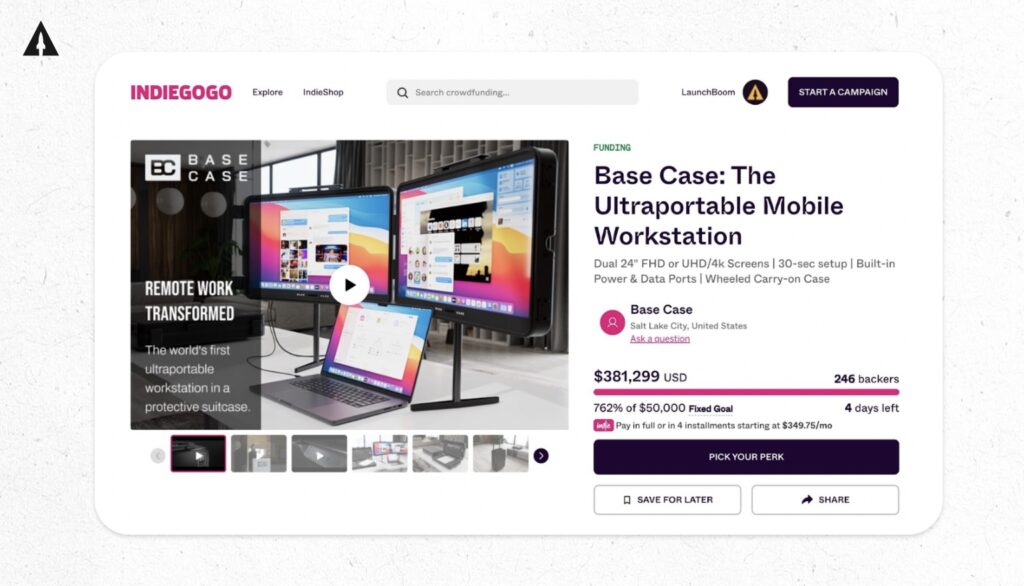
After I choose my perk, this pop up appears:
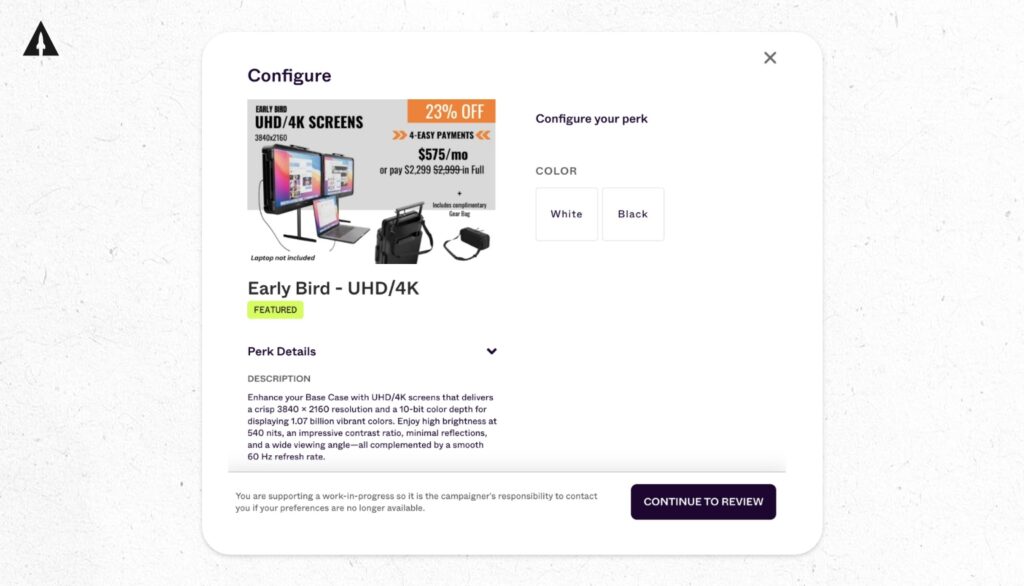
Here’s where I can choose which color I want. This means that on Indiegogo you can set up different variants (like colors) and that will then be shown to the backer during the checkout process. This is a feature that Kickstarter does not have.
Next we’re taken to the cart:

This has multiple aspects that borrow from e-commerce best practices:
- Navigation is removed
- You can update the quantity of the items in your cart (not available on Kickstarter)
- Your total savings and percentage discount is shown (not available on Kickstarter)
- You can add “add-ons” to your cart
Lastly, we’re taken to the payment screen:
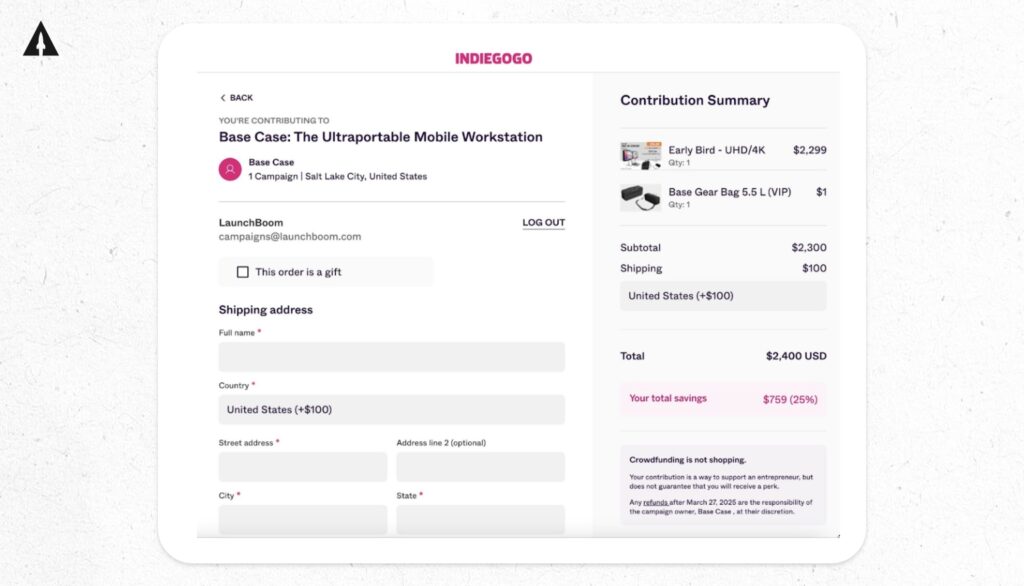
The first thing I want to point out is Gifting. Like it sounds, this lets backers buy rewards for other people. This is a feature that’s not available on Kickstarter. The second thing is that Indiegogo collects backers’ shipping addresses. Again this is something that Kickstarter does not do during the checkout.
One more thing to note is that Indiegogo has something called Indiegogo Tip on their checkout. This is a tip that is automatically added on top of the backers order that goes directly to Indiegogo. Backers are allowed to tip $0, but it will default to an amount over $0 and creators cannot turn this feature off. It looks like this:
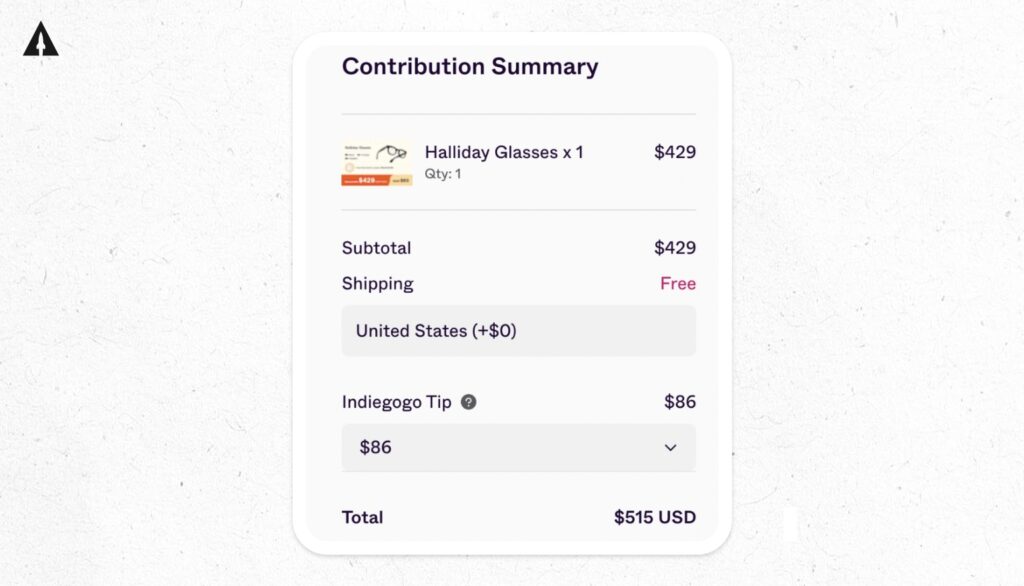
I don’t know for sure, but all my experience in marketing makes me believe that this feature does not positively affect conversion rates in the checkout. You can learn more about the Indiegogo Tip feature here.
Kickstarter Checkout
Kickstarter’s checkout may not have as many features as Indiegogo, but it’s still good and has a few differences that are worth understanding. Again, let me go through an example of a client to show you what it looks like. This time I’ll show you the Slingah System campaign:
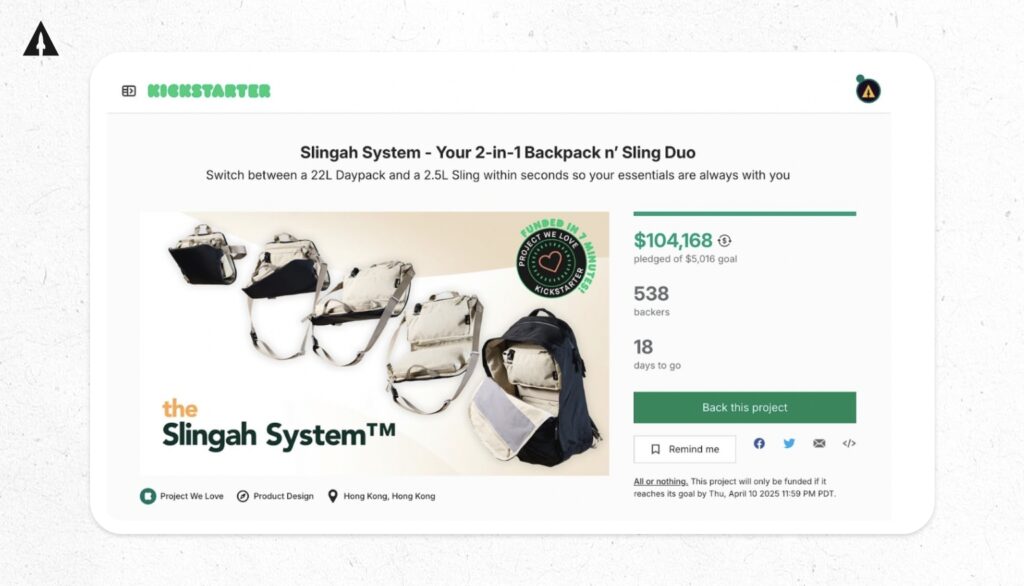
So after you choose your reward you’ll be taken to a page that looks like this:
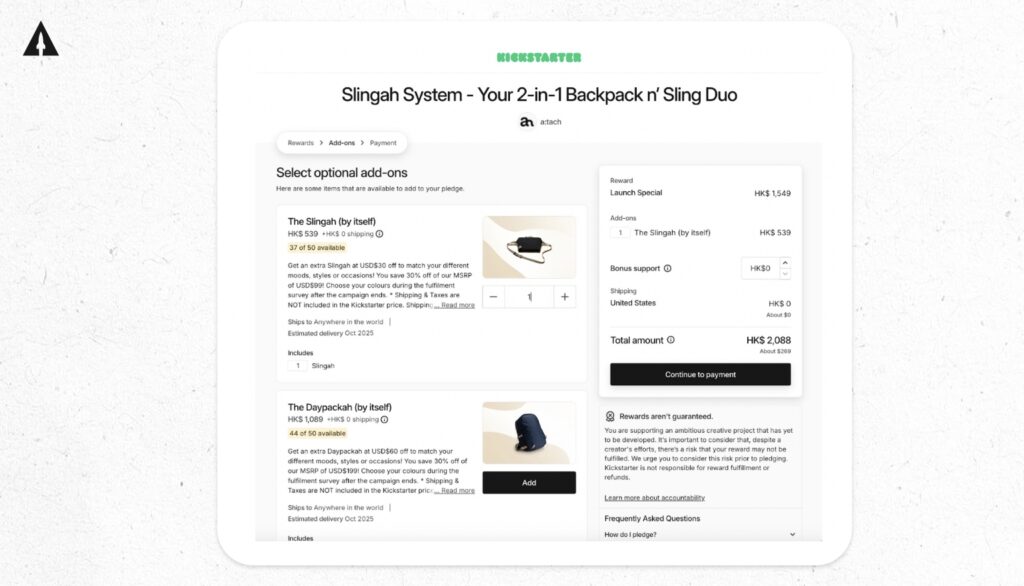
Some things I like about this page:
- The navigation is removed
- It shows a progress bar so backers know how many steps there are in the checkout process
- You can select add-ons to add to your pledge
- You can change the quantity of the add-ons
Some things I don’t like about this page:
- You cannot choose variants like you can on Indiegogo
- You aren’t shown any types of discounts or savings
After you click on Continue to payment, we go to the payment screen:
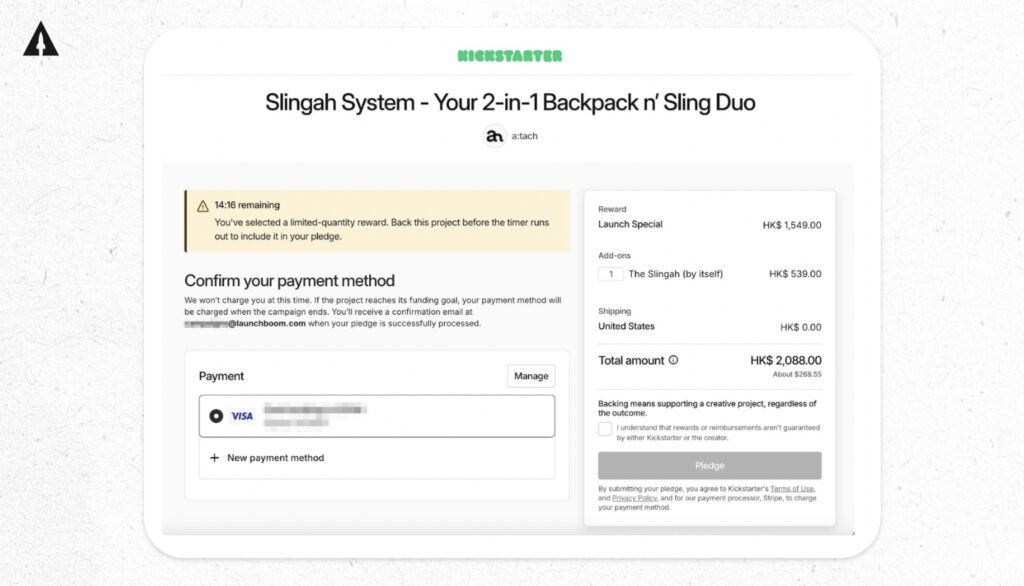
This page is super simple, which I love. Another really cool feature that Kickstarter has that Indiegogo doesn’t is the countdown timer. This urgency will drive backers to complete their purchase.
Overall, while Kickstarter’s checkout is streamlined and has a few cool features, I think that Indiegogo’s is better. I’m always going to favor when platforms choose to incorporate best practices from e-commerce.
| Feature | Kickstarter | Indiegogo |
| Multiple Quantities | Limited – only for add-ons | Yes |
| Gifting | Not built-in | Built-in feature |
| Platform tipping | Not available | Available (on by default) |
| Overall Experience | Streamlined but less flexible | More like e-commerce |
4. Pre-Launch Features
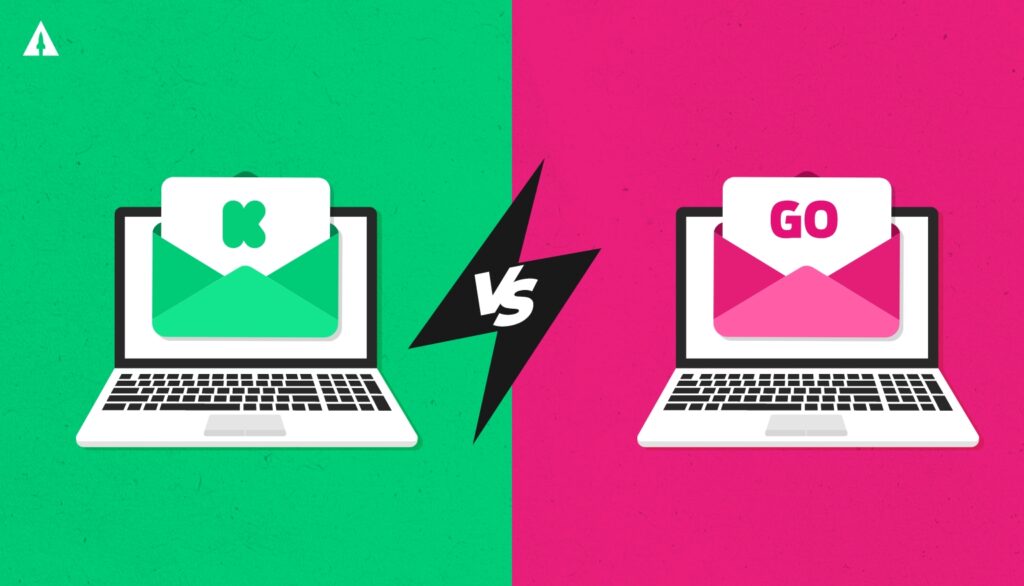
The pre-launch phase has become absolutely critical to crowdfunding success. We’re seeing many campaigns now generate 30-50% of their funding from audiences they built before they even launched. Both platforms offer tools to help with this crucial phase, but they take very different approaches.
Pre-Launch Pages
Pre-launch pages let you build awareness and collect info from potential backers before your campaign goes live. Think of them as landing pages for your pre-launch marketing efforts – they help you gauge interest while building an audience of people who are actually excited about your product.
Indiegogo Pre-Launch Pages
Indiegogo’s pre-launch pages offer a structured system with sections you can customize:
- You access it through the Campaign Editor while your campaign is in draft mode
- You get several customizable sections including a Header Image, Introduction, and Project Feature
- Email collection is the main call to action (and backers don’t need an account)
- Your page can be discovered by potential backers browsing the platform
- You can download all the email addresses you collect for your own marketing
Here’s an example of the Pre-Launch Page for Staples’ upcoming product called BRIGHTWELL:
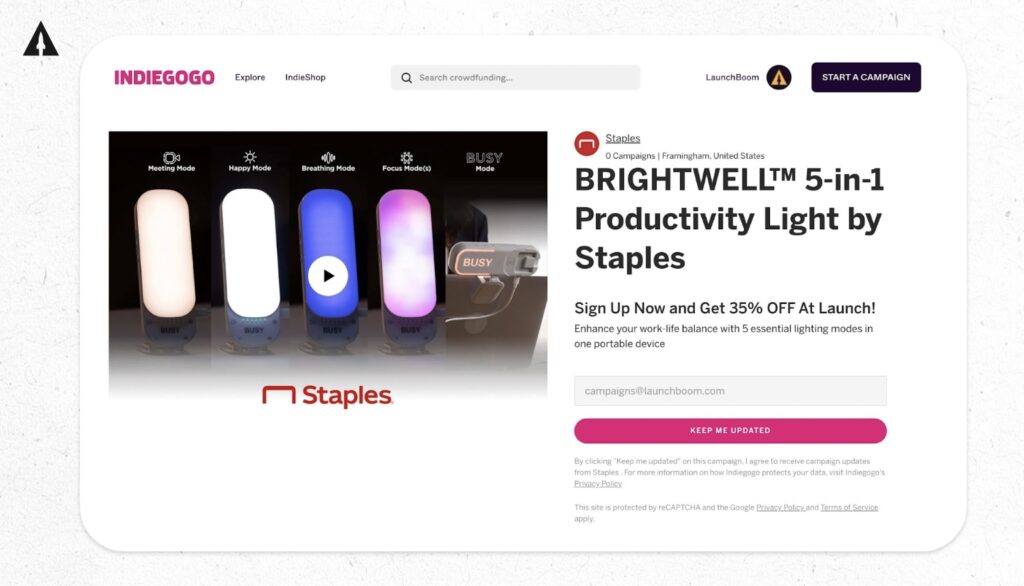
You can find all the details about setting up and managing Indiegogo pre-launch pages in their support documentation.
While Indiegogo’s pre-launch pages don’t give you as much design flexibility as their full campaign pages, they provide the essential tools you need to build an audience. The system uses predefined sections that you can enable or disable, which keeps a consistent structure across all pre-launch pages.
Kickstarter Pre-Launch Pages
Kickstarter takes a completely different approach:
- You use the same campaign page editor as live projects, which gives you good customization options
- “Follow” is the primary call to action (but requires people to create or log into a Kickstarter account)
- Your page can be discovered through Kickstarter’s project discovery systems
- You cannot access your followers’ email addresses directly
- Kickstarter sends automated notifications when your project launches
Here’s an example of one of our client’s Pre-Launch pages, Murder on the Rocks:
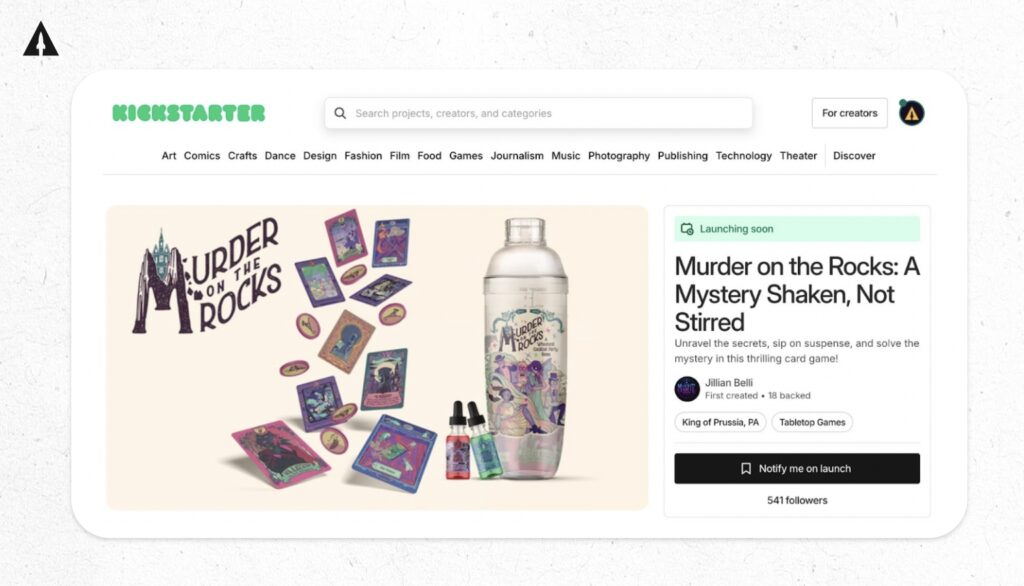
The big limitation with Kickstarter’s approach is you can’t directly access your followers’ contact information. While Kickstarter does send automated notifications when you launch, you can’t communicate directly with your followers during the critical pre-launch phase. If you want more info, check out Kickstarter’s article “How to Craft a Pre-Launch Page.”
This represents a huge difference in how you build an audience on these platforms. With Indiegogo, you can download email addresses and run a more sophisticated pre-launch nurturing campaign. With Kickstarter, you’re stuck relying on their built-in notification system without any direct communication capabilities. With that said, the Kickstarter notifications do a pretty good job of getting prospective backers to convert, but more on that in the next section.
| Feature | Kickstarter | Indiegogo |
| Customization | Pretty customizable | Structured sections |
| Call to Action | “Follow” (requires account) | Email signup (no account needed) |
| Discoverability | Yes | Yes |
| Email Access | No direct access | Download available |
Email Marketing
Being able to talk directly with potential backers before you launch is absolutely critical to crowdfunding success. The two platforms take completely different approaches to this key marketing channel.
Indiegogo Email Marketing
Indiegogo hasn’t built email marketing tools into their platform, but you can download the email list as a CSV and upload it into your own email marketing platform. If having control over your email marketing is what you’re after, then this is a big pro for Indiegogo. If you just want the platform to handle it for you, then this is a big con.
Kickstarter Email Marketing
Kickstarter keeps tight control over backer communication, but will manage all of the email marketing for you:
- They send three automated notifications to your followers:
- One when your campaign launches
- One 48 hours before your campaign ends
- One 8 hours before your campaign ends
- They don’t give you direct access to your followers’ email addresses
- You can’t customize these automated messages
- You can’t directly communicate with your followers before launch
Now while I can’t recommend Kickstarter’s email marketing for those looking for more sophisticated marketing strategies, it is a good option for creators who don’t have their own email marketing software. Plus, Kickstarter’s notifications do a good job of getting backers to convert – it’s normal to see ~10-15% of the follower list back the campaign within the first 48 hours of the campaign launching.
But if you’re looking for an option that’s better than what both Kickstarter and Indiegogo offer, then pay special attention to the next section.
Advanced Pre-Launch Tools
If you’re looking to maximize your pre-launch potential, both Kickstarter & Indiegogo’s tools won’t help you do it. You need software that’s more powerful…
(get ready for my shameless plug)
Software like LaunchKit.
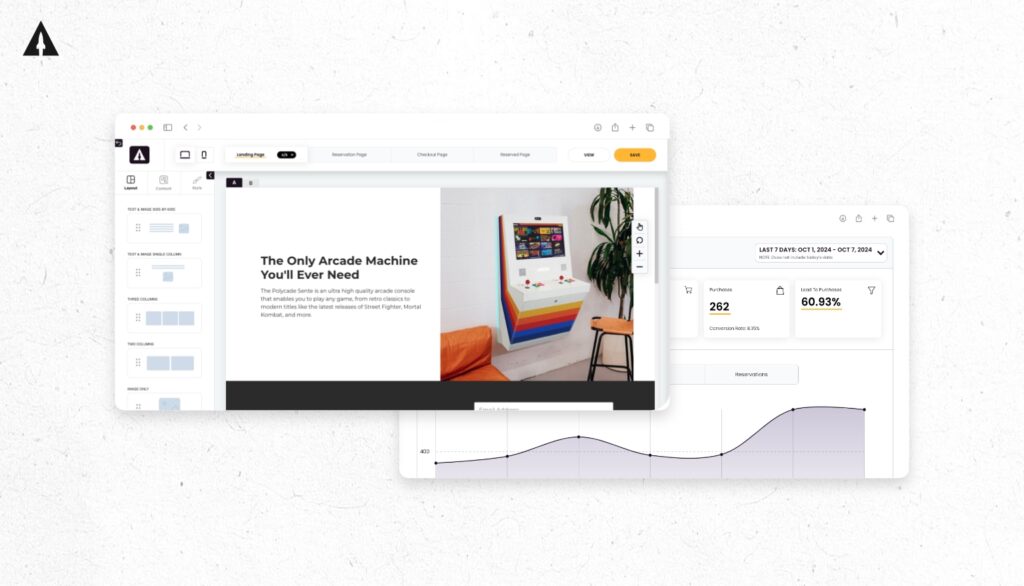
LaunchKit is a tool we developed at LaunchBoom. It’s specifically designed to help creators build highly qualified pre-launch audiences and includes features like:
- An intuitive drag-and-drop funnel builder for creating high-converting reservation funnels
- An integrated analytics dashboard that puts all your critical pre-launch metrics in one place
- Audience targeting tools that leverage crowdfunding-specific data
Technology plays an increasingly important role in campaign success. LaunchKit streamlines the pre-launch and community building process with features that help you develop high-converting reservation funnels even if you’re not technically skilled.
As Ricardo, a client whose Floral Dragons campaign raised $1,163,164 on Kickstarter, said: “LaunchBoom’s LaunchKit is a great tool for audience building. It helped us generate leads and keep track of how well things were performing. The $1 pledge really helped us estimate campaign success.”
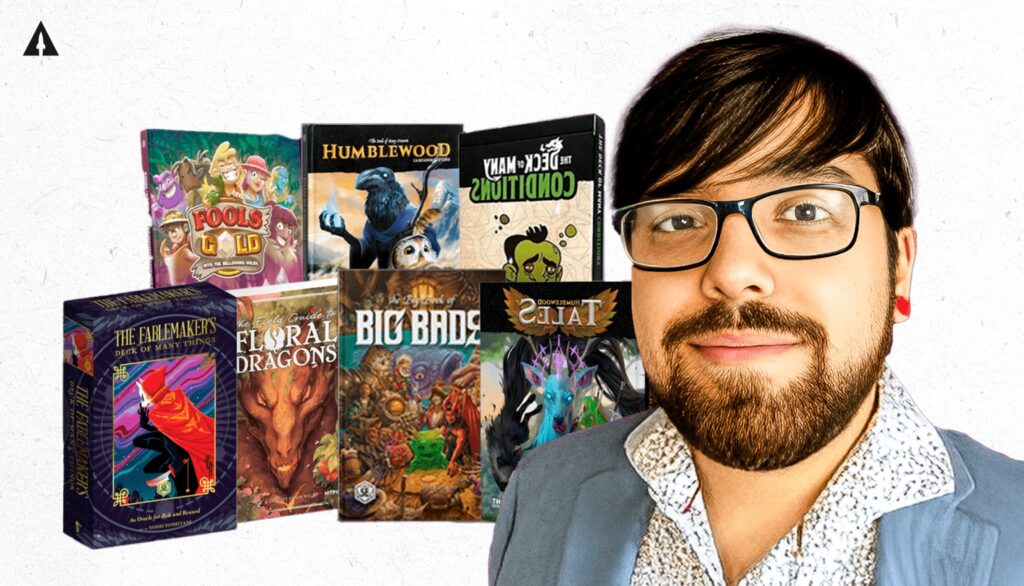
These specialized tools can complement either platform’s native features, addressing their limitations and providing advanced functionality specifically designed for crowdfunding success.
If you’re interested in using it, reach out to us here.
5. Live Campaign Features
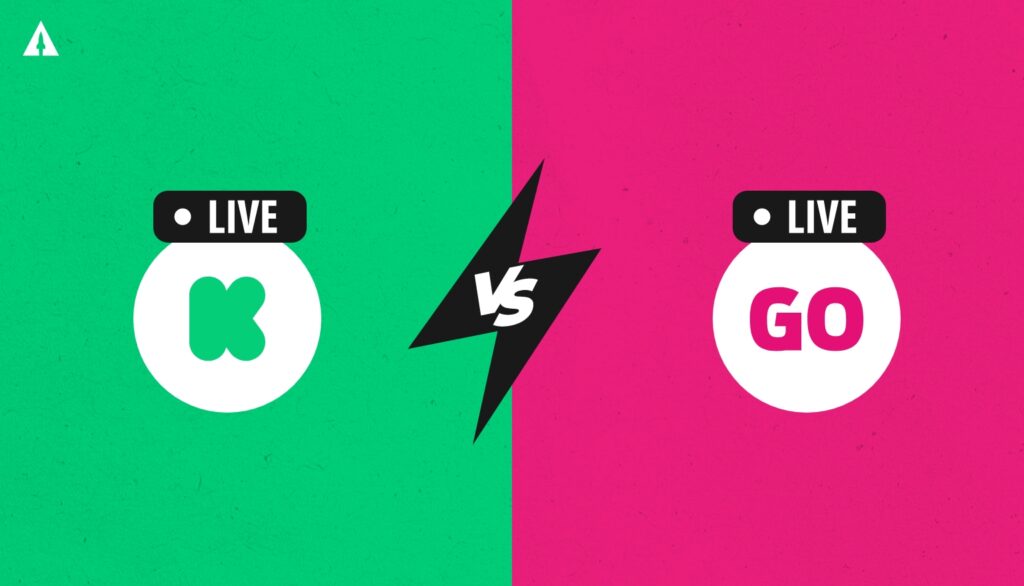
Once your campaign is live, the features and tools each platform gives you will make a big difference in how well you can manage your campaign, talk to your backers, and maximize your funding.
Campaign Page Builder
The importance of the campaign page is often overlooked. But as the primary place where backers are convinced to back your project, your campaign page should be given a lot of attention, which is why having the right campaign page builder is equally as important. Let’s dive into the differences.
Indiegogo Page Builder
Indiegogo’s campaign page builder is more feature-rich and flexible than Kickstarter’s. Most creators will probably stick to the basic capabilities, but more advanced users may find the extra features welcoming.
I’ll explain the differences by showing you the campaign page builder of our client, Reliq.
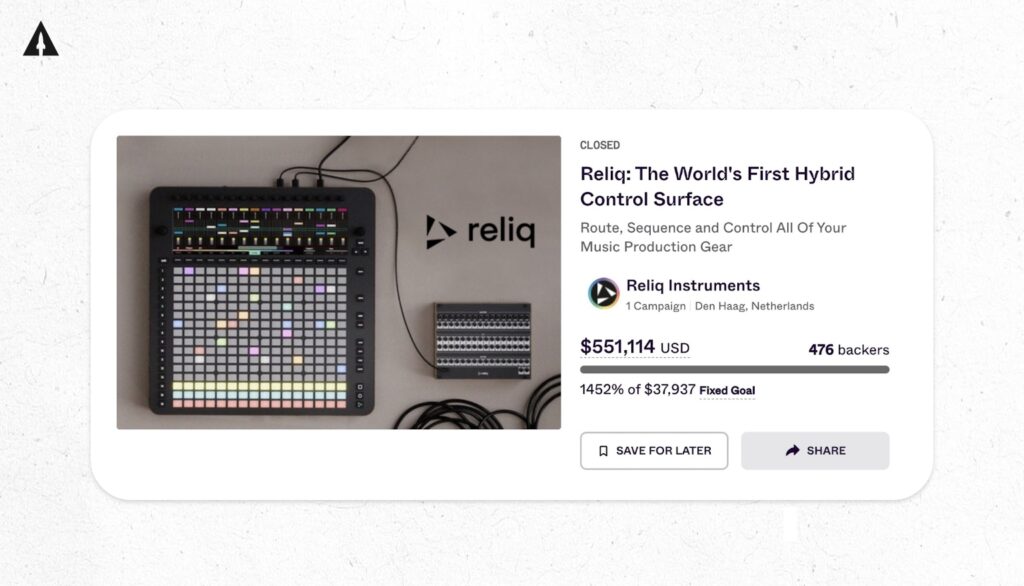
First, let’s start with the campaign video player. On Indiegogo, you must use either a YouTube or Vimeo link. In the case of Reliq, they chose YouTube:
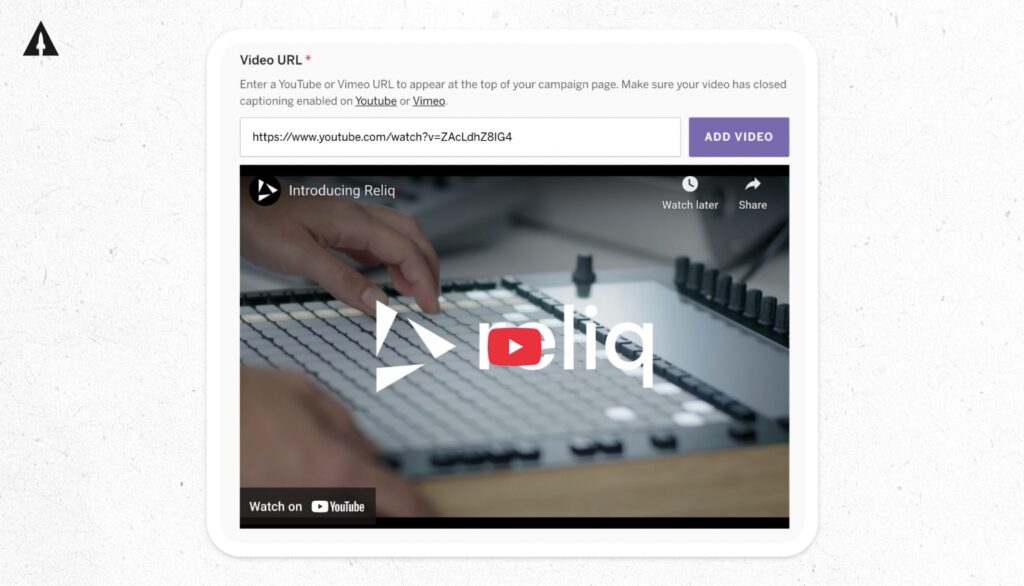
Kickstarter does not give you the option to use YouTube or Vimeo for the campaign video. Instead, they use their own native video player which I don’t think is as good as YouTube or Vimeo.
Next, let’s go into the actual campaign page builder for Reliq. It looks like this:
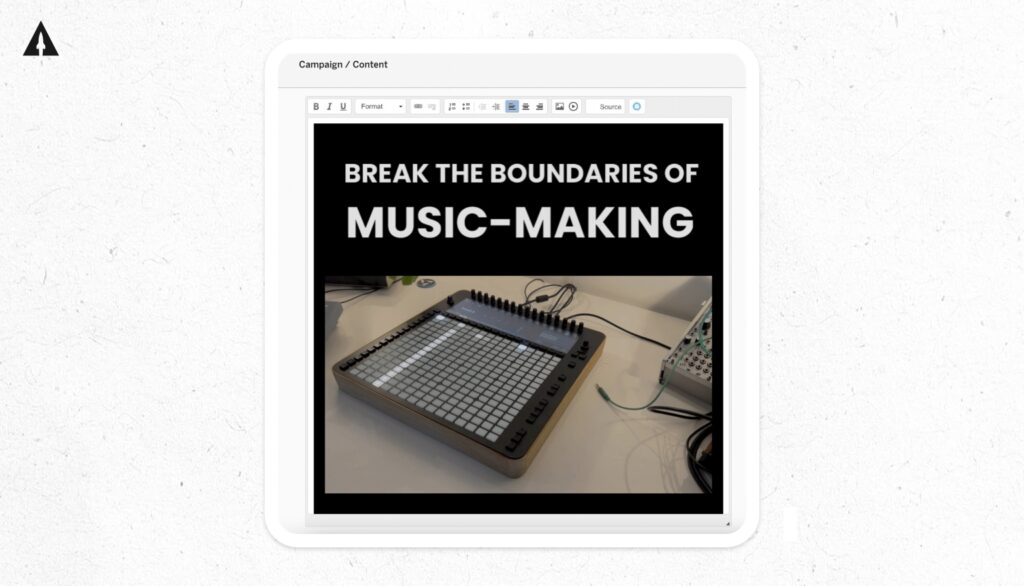
Yep, it’s pretty straightforward.
On the top, you’ll find the controls, which aren’t too complex but at the same time give you quite a lot more options than Kickstarter’s editor. The biggest differences come in the form of formatting choices you have. For example, on Kickstarter, you don’t have the option for italic, underline, center & right alignment, numbered lists, and a few others.
The most notable difference is that the Indiegogo campaign page builder has the “source” button in their controls. Clicking that gives you access to the HTML of your campaign page, meaning more advanced users can get a not more nitty gritty with the customization of their page if they’d like.
Kickstarter Page Builder
If Indiegogo’s page builder is all about flexibility and control, then Kickstarter’s is about simplicity and consistent aesthetics. Their campaign page builder is beautifully designed, yet it lacks advanced controls for power users. That doesn’t mean you can’t make great pages though – you just have to work within different constraints.
I’ll show you what I mean by sharing the campaign page builder of our client Pulli Bin.
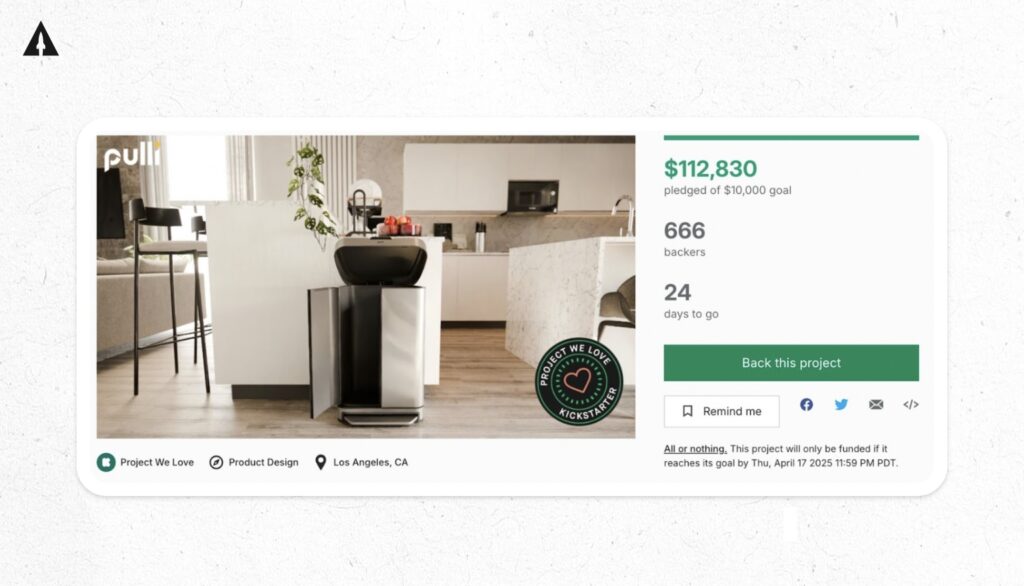
Like before, let’s start with the campaign video.
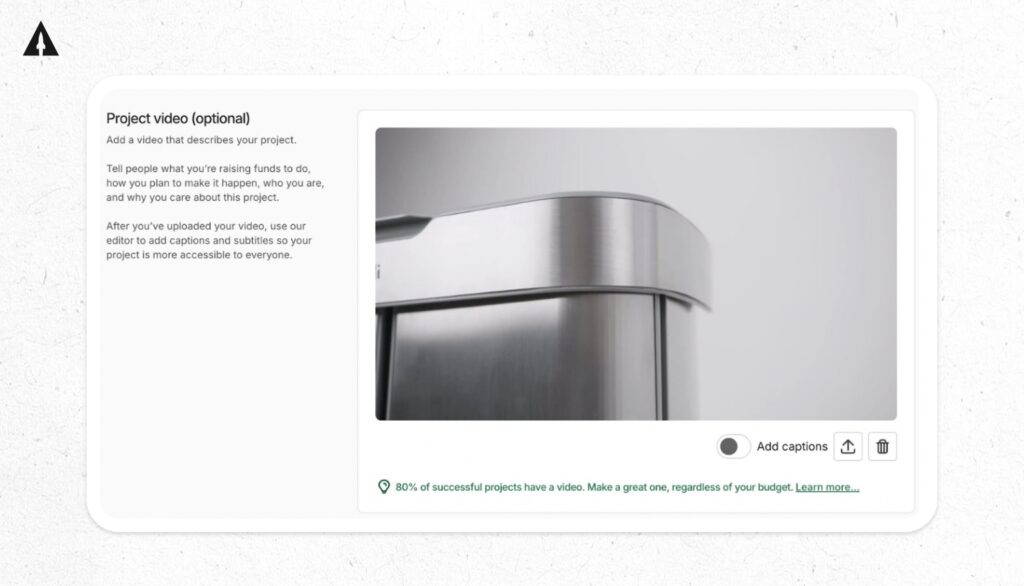
You’ll have to upload your video directly to Kickstarter and use their native player – no YouTube or Vimeo options here.
Next, let’s go to the campaign page builder.
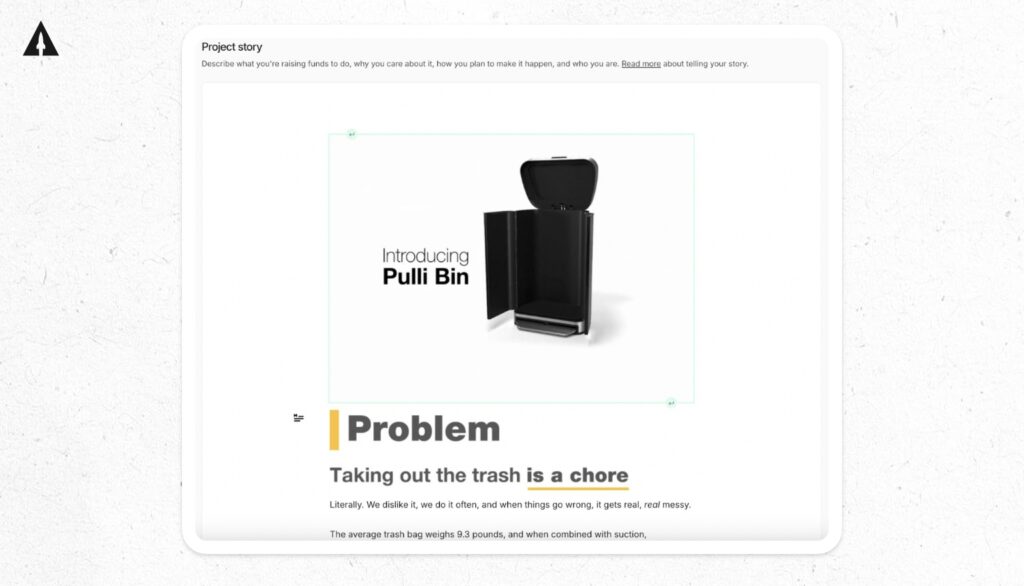
Compare this page builder to Indiegogo and it’s much more clean and minimalist. The controls don’t appear by default, but instead show up when you click into the page builder and look like this:
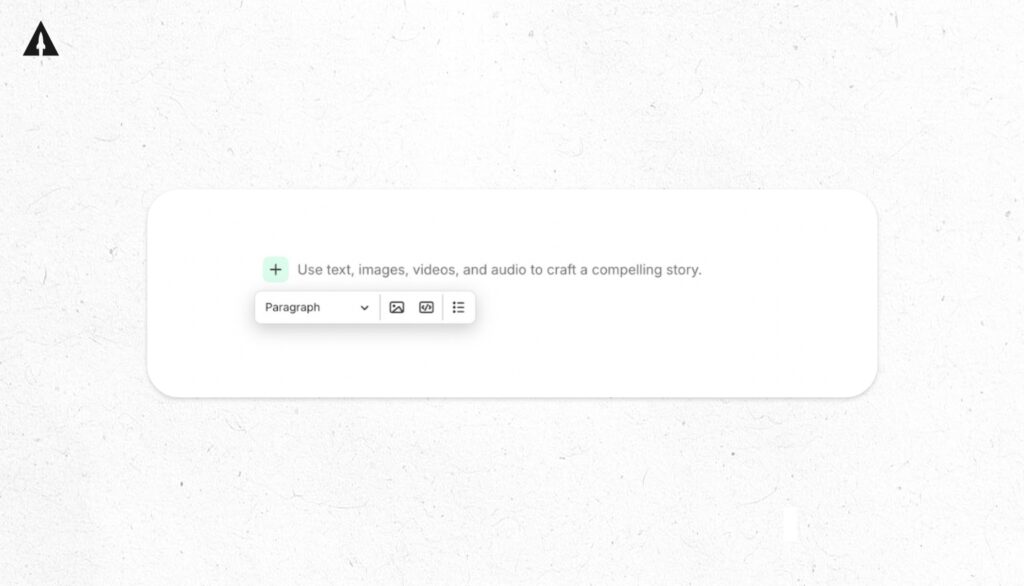
The main options you have are the following:
- Choose between header, subheader, and paragraph text
- Upload an image or gif
- Embed lots of media types (YouTube, Vimeo, Soundcloud, Bandcamp, etc.)
- Make a bulleted list
So yes, Kickstarter’s campaign page builder is more restrictive than Indiegogo’s, but that’s not necessarily a bad thing. It does tend to create more visually consistent campaigns across their platform, which can benefit creators by providing a familiar structure for returning backers.
At the end of the day, both campaign page builders are going to get the job done, but here’s a table to compare the differences.
| Feature | Kickstarter | Indiegogo |
|---|---|---|
| Formatting | Less options | More options |
| HTML access | No | Yes |
| Video Hosting | Native player | YouTube or Vimeo |
| Overall Structure | More standardized | More customizable |
| FAQs | Yes | Yes |
Rewards & Perks
The rewards systems (called “perks” on Indiegogo) are a crucial part of your campaign. Think of rewards as the product offerings on your page. It’s what people will be buying.
Both platforms let you offer specific items or experiences in exchange for financial support, but they handle this in different ways with their own unique features and limitations.
Indiegogo Rewards/Perks System
Indiegogo’s perks system comes with several standout features:
- Variants: You can offer different versions of the same perk (colors, sizes, etc.) within a single listing, making it much easier for backers to select what they want
- Secret Perks: These are exclusive offerings only visible to backers who get a direct link – perfect for special promotions or rewarding loyal followers
- Featured Perks: These highlighted options appear prominently on your campaign page
- Add-ons: These are extra items backers can add alongside their main perk
- Limited Quantity: You can restrict how many of a specific perk are available
- Perk images: you can add an image to visually show the perk and/or add-on
- Discounting: you can set a retail price and a perk price. Indiegogo will automatically calculate the discount off of retail and display that discount percentage on the perk.
- Shipping costs: you can set up shipping rates for each reward and collect it through Indiegogo
Like I said during the Checkout section, Indiegogo tries to use e-commerce best practices wherever they can, and how they designed their perk system is no exception.
Kickstarter Rewards System
Kickstarter’s rewards system has:
- Secret Rewards: like Indiegogo, you can create exclusive offers via direct links
- Featured Reward Capability: like Indiegogo, you have the option to highlight specific reward tiers
- Add-ons: like Indiegogo, you can set up upselling through their add-on system
- Limited Quantity Options: like Indiegogo, you can cap availability for specific rewards
- Limited-Time Functionality: This is a unique feature to Kickstarter that lets you offer rewards only during specific timeframes
- Reward images: like Indiegogo, you can add images to your rewards and/or add-ons
- Shipping costs: like Indiegogo, you can set up shipping rates for each reward and collect it through Kickstarter
That limited-time feature is a really cool feature that only Kickstarter has. It creates natural urgency by making certain rewards available only for specific periods during your campaign. For example, you can set early bird discounts to automatically expire after a set time, driving early momentum.
At the end of the day, both platforms support the core reward functions you need, but if you’re looking to understand all the differences, check out this table
| Feature | Kickstarter | Indiegogo |
| Terminology | “Rewards” | “Perks” |
| Variant support | No | Yes |
| Secret Offers | Yes | Yes |
| Featured Placement | Yes | Yes |
| Add-ons | Yes | Yes |
| Limited Quantity | Yes | Yes |
| Limited Time | Yes | No |
| Native discounting | No | Yes |
| Reward images | Yes | Yes |
| Shipping rates | Yes | Yes |
Updates & Messaging
Talking with your backers during a live campaign is super important for keeping momentum, answering questions, and building a community. Both platforms give you tools to do this, though they take different approaches.
Campaign Updates
Both Kickstarter and Indiegogo have solid update systems that let you share ongoing progress, answer common questions, and keep backers engaged throughout your campaign. The data is clear on this one (and counterintuitive) – there’s a strong link between regular updates during the live campaign and having backers refund their pledge. That’s why I recommend not sending out too many updates during the live campaign. Instead, only share the most important updates.
In terms of how each platform manages updates, it’s essentially the same. Both will add the update to the campaign page and notify backers via email. Here’s how each of the editors look.
Indiegogo’s Update Editor:
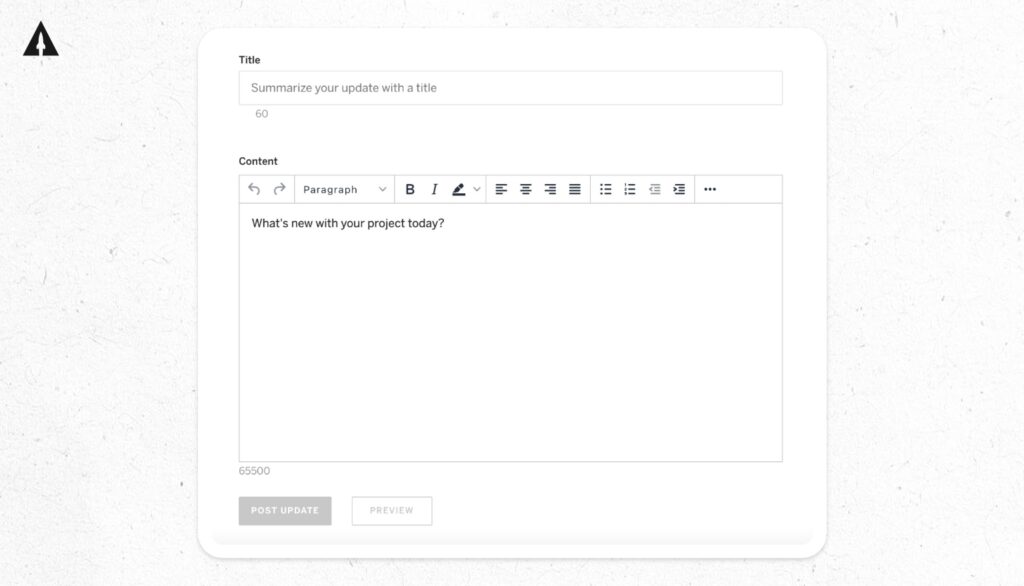
Kickstarter’s Update Editor:
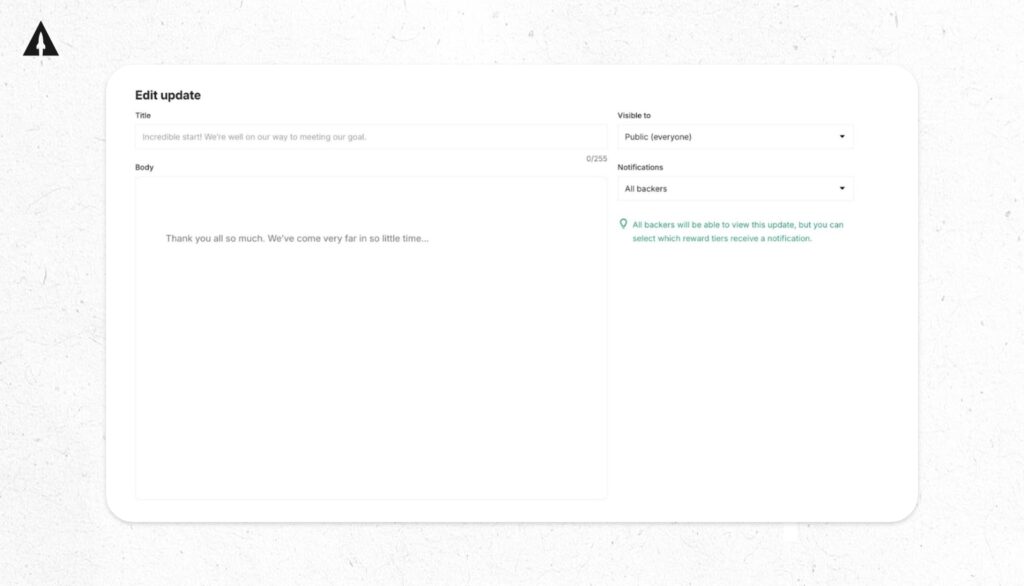
Both use the same editors as their campaign page builders.
The biggest difference between the two is that on Kickstarter you can adjust the visibility of the update. Just want to send it to certain reward tiers? You can do that. Only want backers to be able to view it on your campaign page? You can do that too.
Backer Messaging
The platforms handle direct backer communication a bit differently:
- Kickstarter uses an internal messaging system that requires Kickstarter accounts. This creates a contained environment for all campaign-related communications and can be really helpful for creators who don’t have their own customer support software.
- Indiegogo requires creators to give a support email address. When backers send a message to the creator, that will appear in the support email inbox that the creator set up.
No matter which platform you choose, regular, transparent communication is always the way to go. Campaigns that maintain consistent updates typically see higher engagement rates, fewer refund requests, and stronger community development than those where creators barely interact with backers.
Analytics & Tracking
A good analytics & tracking system makes it easy for a creator to understand how well their crowdfunding campaign is performing. Let’s see how each of the platforms approach analytics to see which one is better for you.
Platform Analytics Dashboards
To make it simple, both Kickstarter & Indiegogo have fairly straightforward and easy to understand dashboards. There are some small important differences, but let me talk about the similarities first.
Here’s a look at the main analytics dashboard for our client’s Kickstarter campaign called NitroPress:
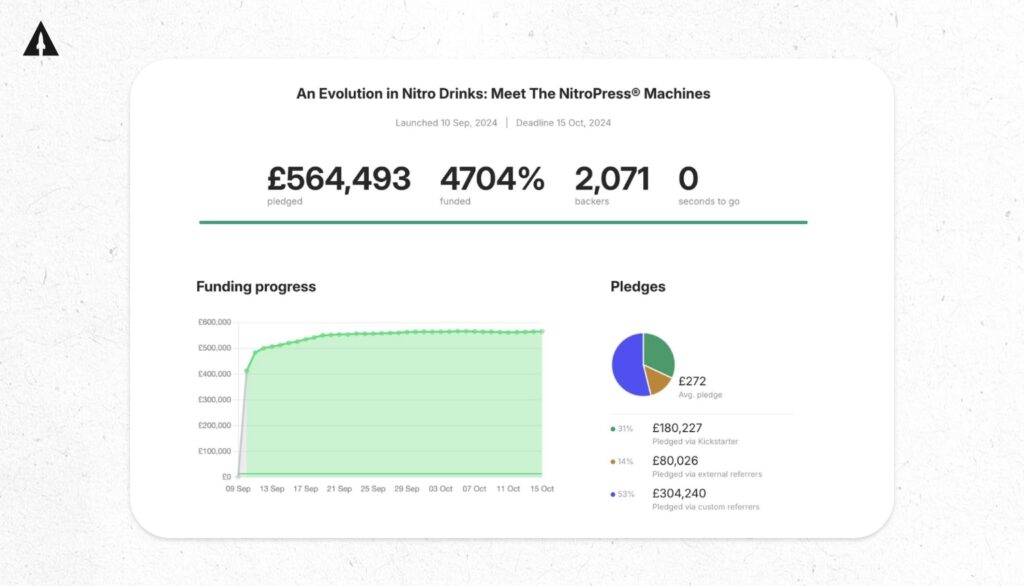
And here’s the analytics dashboard for our client’s Indiegogo campaign called Brighter:
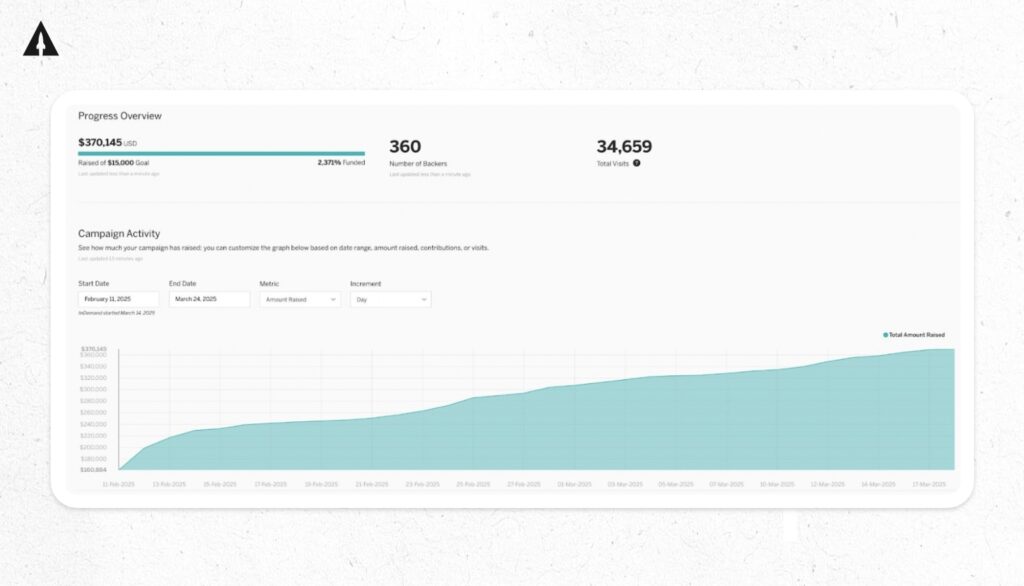
These two screenshots just show the top of the analytics dashboards on each platform. So let me list out what else in on the dashboards that are similar on both platforms:
- Breakdown of funds attributed to the platform’s community
- Breakdown of funds attributed to custom referral sources
Speaking of custom referral sources, this is where I’d give the edge to Kickstarter. On Kickstarter, you can create custom referral sources really easily in the backend and then track the performance of those sources in the dashboard. You can create custom referral sources in Indiegogo too, it’s just not as intuitive. Here’s a help article going over it.
External Analytics Integration
Advanced creators shouldn’t only rely on the platform’s built in analytics tools. You should also integrate into third party analytics. Let’s see how each platform manages external analytics:
Kickstarter has the following options:
- Google Analytics
- Meta Pixel
- Meta Conversions API
Indiegogo has the following options:
- Google Analytics
- Google Ads Pixel
- Meta Pixel
- Meta Conversions API
- TikTok Pixel
If tables are more your thing, here’s one comparing the two:
| Feature | Kickstarter | Indiegogo |
| Dashboard | Good | Good |
| Referral Tracking | Yes (easier to use) | Yes |
| Google Analytics | Yes | Yes |
| Google Ads Pixel | No | Yes |
| Meta Pixel | Yes | Yes |
| Meta Conversions API | Yes | Yes |
| TikTok Pixel | No | Yes |
| Data Export | Yes | Yes |
6. Post-Campaign Features

After your successful campaign ends, both platforms offer features to help you keep the momentum going, generate more sales, and manage fulfillment. But these post-campaign tools are quite a bit different between the two platforms.
Late Pledge & Continued Sales
Both platforms have figured out there’s value in letting you sell beyond your initial campaign period, but they handle this in very different ways.
Kickstarter Late Pledge
Kickstarter’s Late Pledge feature is relatively new and was announced in April of 2024:
- It lets you keep accepting pledges after your campaign officially ends
- It maintains your original campaign page look and feel
- It keeps the familiar Kickstarter browsing and pledge experience for backers
For example, check out our client’s campaign called Aspens. You can see the blue bar at the top that lets backers know the campaign is in Late Pledge.
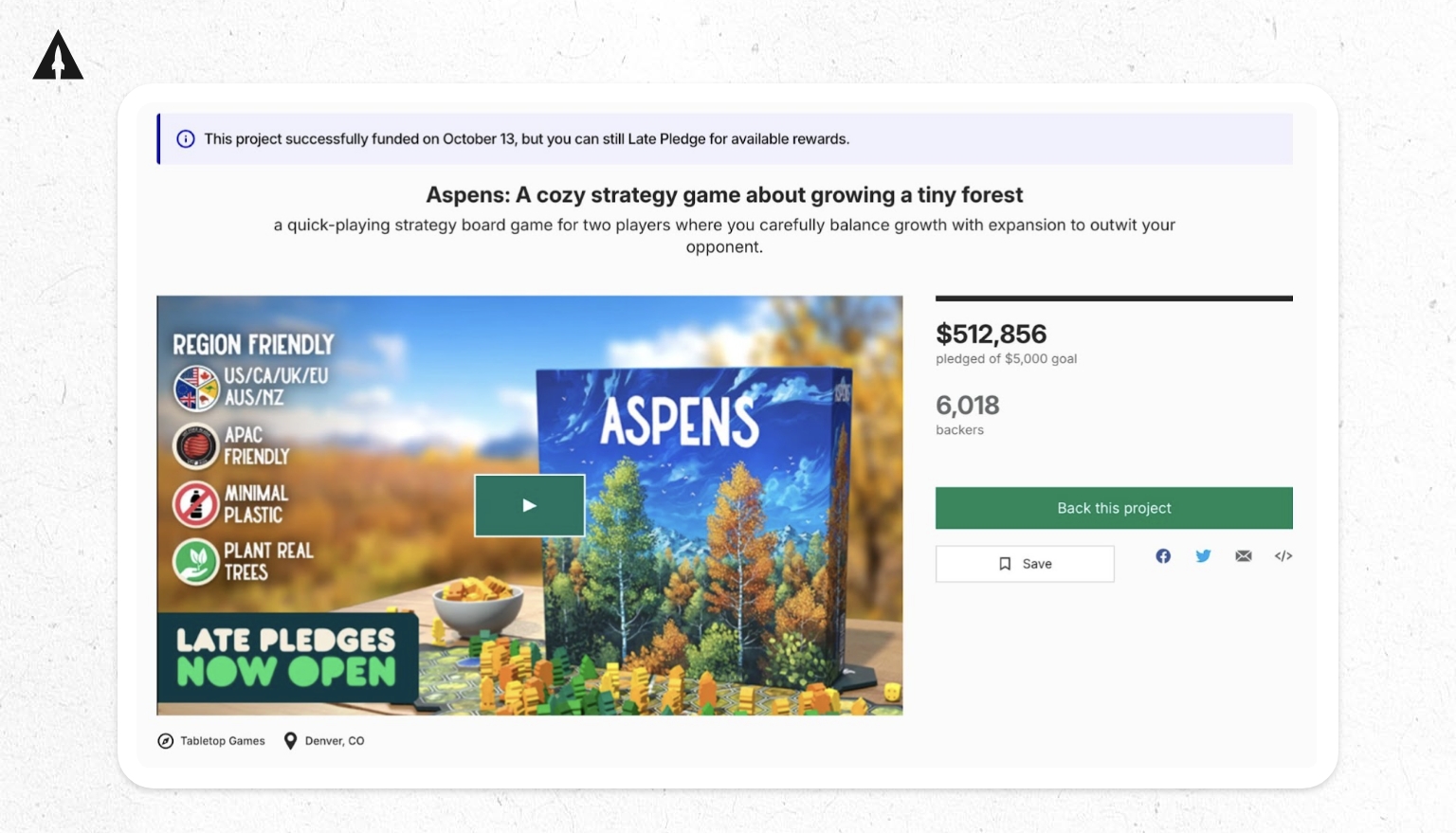
Their campaign actually ended at $470,835, which means they’ve raised an additional $42,021 through Late Pledges. I highly recommend you use this feature if you launch on Kickstarter.
Indiegogo InDemand
Indiegogo’s InDemand program is a more established post-campaign solution but it works essentially the same as Kickstarter:
- It was introduced way back in 2014 (originally called “Forever Funding”)
- It lets your campaign transition smoothly into ongoing sales
- It works like a permanent storefront that keeps your campaign’s branding
For example, check out our client’s campaign called Brighter, which is currently funding on Indiegogo InDemand:
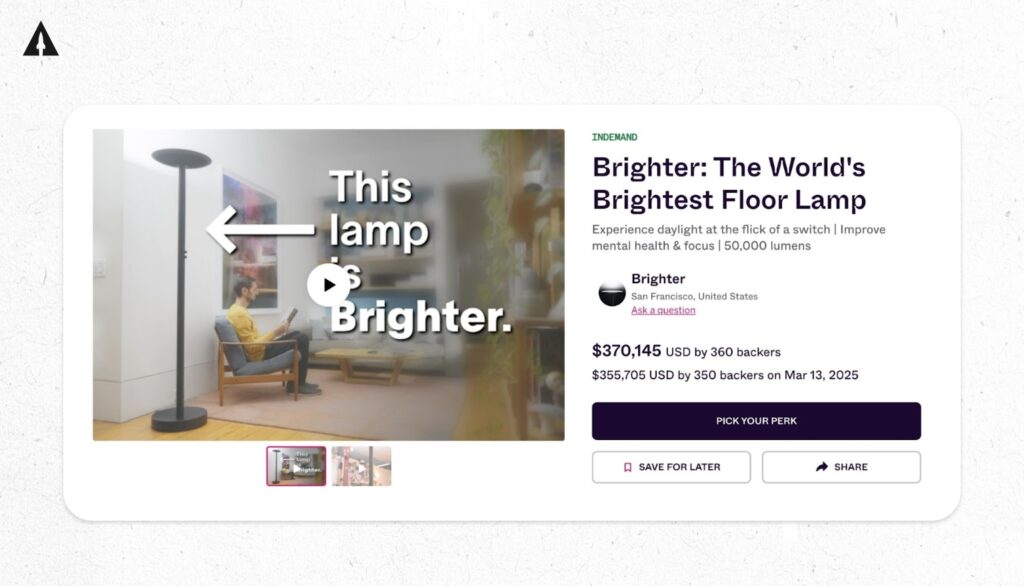
They raised $355,705 on their campaign and have since brought that total to $370,145 through InDemand.
An important thing to note is that Kickstarter creators can use Indiegogo InDemand too. Although, with Late Pledge now available on Kickstarter, there’s not much of a reason to do it unless Indiegogo offers you a very enticing promotional deal.
| Feature | Kickstarter | Indiegogo |
| Terminology | Late Pledge | InDemand |
| Duration | Can continue indefinitely | Can continue indefinitely |
| System Maturity | Developing (although functions fine) | Well-established |
Surveys & Pledge Management
Once your campaign ends, the heavy lifting really begins. One of the heaviest lifts will be fulfilling your orders to backers. That’s why pledge management is so important to get right. I’ll walk you through how each of the platforms approach it.
Kickstarter Pledge Management
Before we talk about pledge management, you need to understand two very important things about Kickstarter:
- They do not allow backers to select variants when they are checking out. This means if your product has options like sizes or colors, backers can’t tell you what they want when they pledge.
- They do not collect shipping information when backers are checking out.
Because Kickstarter doesn’t do these two things, pledge management is vital. Think of pledge management as a system in the post-campaign that collects all the important info you need from backers to make sure you ship them the right stuff to the right address.
Kickstarter has a built-in tool called Surveys which is very basic but can collect all of this information from backers. If creators have more than 100 backers and want some advanced options, then I’d recommend using a third-party pledge manager like PledgeBox, BackerKit, Hive, or PledgeManager.com.
Now very recently Kickstarter announced that they are going to release their own Pledge Manage in 2025. Currently it’s in beta, but by the time you are reading this it may already be released. So be sure to check
Indiegogo Survey System
Now because Indiegogo collects variant & shipping information at checkout, creators should have all the information they need to fulfill their orders. With that said, most creators who are looking for more advanced pledge management features still opt for third party pledge managers like the ones I listed above.
Alright, let’s compare the two:
| Feature | Kickstarter | Indiegogo |
| Native Pledge Management | New system in beta for 2025 | Basic functionality plus checkout data |
| Third-Party Integration | Yes | Yes |
| Information Collection Timing | Post-campaign | During checkout |
Pros and Cons of Indiegogo and Kickstarter
Looking at both platforms side by side, we can now break down their strengths and weaknesses to help you decide which one is right for your campaign.
Kickstarter Pros
- Larger Community: 23+ million backers with substantially higher engagement metrics
- Higher Success Rate: Approximately 42% overall success rate compared to Indiegogo’s estimated 18-30%
- Strong Organic Traffic: Campaigns typically receive 20-30% of funding from platform discovery
- Category Dominance: Exceptional performance in Games, Design, and creative project categories
- Trust Factor: All-or-nothing funding model creates stronger backer confidence
- Project We Love Badge: Provides significant visibility and credibility when earned
- Limited-Time Rewards: Creates powerful urgency mechanism during campaigns
- New Pledge Management: Integrated tools coming in 2025 will streamline fulfillment
Kickstarter Cons
- Stricter Requirements: Mandatory functional prototype and pre-approval process
- Less Flexibility: All-or-nothing funding only, no flexible option
- Limited Email Access: No ability to download follower email addresses
- Less Customization: More limited page design and checkout options
- Geographic Restrictions: Available in fewer countries than Indiegogo
- No Paid Promotions: Cannot purchase homepage placement
Indiegogo Pros
- Funding Flexibility: Option to choose between fixed or flexible funding models
- Immediate Payments: Backers charged upon pledging rather than at campaign end can lead to fewer failed payments
- Concept Stage Acceptance: Ability to launch with less developed products (rendering stage)
- Email Collection: Download and direct contact with email subscribers
- Customization: More flexible page builder and checkout experience
- Paid Marketing Placements: Option to purchase GOGOPicks and Newsletter placements
Indiegogo Cons
- Lower Success Rate: Approximately 18-30% success rate versus Kickstarter’s 42%
- Smaller Active Community: Fewer repeat backers and lower platform engagement
- Less Platform Traffic: Only 5-15% of funding typically derives from platform discovery
- Reserved Funds: 5% of funds held until delivery, potentially impacting cash flow
- Less Backer Trust: Flexible funding option sometimes creates hesitation among backers
- No Limited-Time Rewards: Lacks this powerful urgency-creating feature
Kickstarter vs Indiegogo – Which Should You Choose?
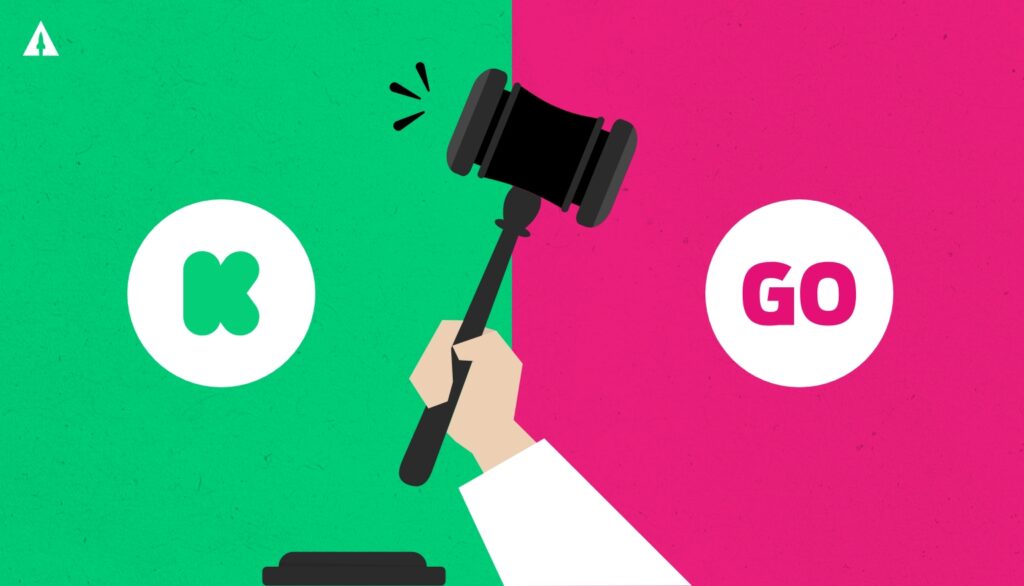
When deciding between Kickstarter and Indiegogo, be strategic. Think carefully about your product category, where you are in development, and your marketing capabilities. Each platform has distinct advantages for different types of campaigns, and choosing the right one for your specific situation can significantly impact how much funding you raise.
The truth is, the crowdfunding landscape in 2025 gives creators more options than ever, with both platforms constantly evolving their features based on creator needs and market trends. The question isn’t which platform is “better” overall, but which one better fits your specific project requirements and goals.
Here are the key factors to consider when making your decision:
- Product Category Alignment: Choose the platform where similar products have succeeded
- Development Stage: Select based on how far along your product is
- Funding Model Preference: Decide whether fixed or flexible funding works better for you
- Marketing Approach: Figure out which platform complements your marketing strategy
- Post-Campaign Plans: Consider your long-term sales and fulfillment needs
At LaunchBoom, our approach has achieved a 97.83% success rate across platforms by applying these principles alongside our launch system. This strategy has worked well across many different product categories and funding goals.
If you’re not sure which platform would serve your project best, our team can give you personalized guidance based on your specific circumstances. Click here to talk with our crowdfunding experts about your project.
I’m looking forward to learning about your product.
Indiegogo vs Kickstarter: Frequently Asked Questions
Which platform has higher success rates?
Kickstarter demonstrates a higher overall success rate of approximately 42%, compared to Indiegogo’s estimated 18-30%. These rates vary significantly by product category, with some categories like tabletop games on Kickstarter achieving success rates as high as 80%.
Can I launch on both platforms simultaneously?
No, this violates both platforms’ terms of service. However, you can launch on Kickstarter and then use Indiegogo’s InDemand feature to continue funding after your campaign ends. I wouldn’t recommend this though now that Kickstarter has their Late Pledge option.
Which platform charges lower fees?
Both platforms charge identical base fees for successful campaigns (5% platform fee plus payment processing). Total fees typically range from 8-12% depending on payment processing rates for your specific country.
Can I launch a charity campaign on these platforms?
Indiegogo allows charitable fundraising campaigns through their Community Projects category. Kickstarter does not permit pure charity campaigns—projects must create something to share with backers rather than simply raising funds for causes.
Do I need a prototype before launching?
For Kickstarter, yes—a functional prototype is required before launch with no exceptions. Indiegogo offers more flexibility and will permit concept-stage projects, though having a prototype generally increases success probability on either platform.
Which platform provides better marketing support?
Both platforms offer marketing programs with similar functionality, but Kickstarter typically provides better organic exposure through its larger backer community. Indiegogo offers more paid promotion options like GOGOPicks for campaigns with marketing budgets.
Can international creators use these platforms?
Yes, though Kickstarter supports creators from 25 specific countries, while Indiegogo is available 33. For creators outside supported regions, Stripe Atlas offers a potential solution by enabling the establishment of a US-based business entity and bank account that can be used for launching on either platform.
Which platform is better for first-time creators?
This depends on your specific project. If you have a functional prototype and fit Kickstarter’s categories, their larger audience may provide advantages. If you’re earlier in development or need flexible funding, Indiegogo might better suit your needs. First-time creators with proper preparation can succeed on either platform.
How long can campaigns run?
Both platforms allow campaigns up to 60 days, though 30 days or less is generally recommended for optimal performance. Shorter campaigns create more urgency and typically demonstrate better momentum. Indiegogo allows extensions within the 60-day maximum window; Kickstarter does not.
What happens if my campaign doesn’t reach its funding goal?
On Kickstarter, no backers are charged. On Indiegogo with Fixed Funding, the same applies. On Indiegogo with Flexible Funding, you keep what you raised even without reaching your goal.
Which platform is better for technology products?
While both platforms host successful technology campaigns, certain technology niches perform better on Indiegogo, particularly products in specialized categories like eBikes.
Can I keep raising funds after my campaign ends?
Yes, both platforms offer post-campaign options. Indiegogo’s InDemand program is well-established, while Kickstarter’s Late Pledge feature continues to develop.
Do I need to handle my own marketing, or will the platform promote my campaign?
You should plan to implement your own comprehensive marketing strategy regardless of platform choice. While both platforms offer discovery mechanisms, neither provides sufficient organic traffic to fully fund most campaigns without creator-driven marketing efforts.
What types of projects are prohibited on both platforms?
Both platforms prohibit projects offering equity, weapons, illegal activities, and certain personal products. Kickstarter specifically bans energy drinks and political fundraising. Always review current prohibited categories on your chosen platform before developing your campaign.



